Chapter 13
Accounting for Inland Branches
LEARNING OBJECTIVES
After studying this chapter, you will be able to understand
The Meaning, Objectives and Classification of Branches
Salient Features of Dependent Branches
System of Accounting for Dependent Branches: The Method of Recording Transaction in the Books of Head Office Under “Debtors System”
Salient Features of Debtors Method of Accounting
To Ascertain Profit/Loss of the Branch (to Ascertain any Missing Figure, to Calculate Profit Margin) by Way of Solving Problems Under Debtors System of Accounting
Accounting Procedure for Dependent Branches Under Stock and Debtors Method (System)
The Procedure for Preparing Profit or Loss of the Branch Under Final Account System
Accounting Procedure for Preparing Branch Trading Profit and Loss Account Under Wholesale Branch Method
Accounting Procedure for Independent Branches and Interbranch Transactions
To Incorporate Net Result of Operations of the Branch in the Books of the Head Office
INTRODUCTION
It may be said that business is the backbone of economy of any country. Generally, any business is bound to grow. Hence the entrepreneurs are constantly engaged in diversifying their production and enlarging their scope of activities. They devise unique and different ways and means for the growth and expansion of business. One way for expanding business ventures is opening their establishments in different places. If the various divisions of a business will be located in different places, they are called branches. Branches may do retail business or wholesale activities or may manufacture their products at different places. The parent body termed as Head Office will control and coordinate the activities of the branches.
It is natural to know the profit or loss of each such branch. As branches vary in nature, accounting practices also vary accordingly. In this chapter, various types of branches, accounting records to be kept by the Head Office (H.O.) and the branch, accounting treatment of transactions with respect to H.O. as well as Branch Office (B.O.) will be discussed in detail. Even in an era of teleshopping, online marketing and the like, the importance of branch has not yet lost its significance. Hence its study will be useful.
OBJECTIVE 1: MEANING OF A BRANCH
“A branch is any establishment carrying on either the same or substantially the same activity as that carried on by the H.O. of the establishment.”
1.1 Main Objectives of Opening a Branch
- To increase the volume of sales
- To enhance profit margin
- To eliminate middlemen in the chain of selling process
OBJECTIVE 2: BRANCH ACCOUNTING
Branch accounting is related to recording of trading transactions of different branches in respect of their dealings with the H.O., with outsiders and other branches.
On the basis of accounting principles, branches are classified as follows:
Classification of branch accounting

Branches accounting depends on the category and some other circumstances that will be discussed further in this chapter.
This chapter is concerned with accounting for inland branches or home branches:
- These branches are situated in the same country where their H.O. is situated
- From the accounting point of view, these branches, in general, do not maintain complete records of their transactions (but which maintain complete records of its transactions are called independent branches).
From branch accounting point of view, inland branches are further classified into
- Dependent branches
- Independent branches
OBJECTIVE 3: ACCOUNTING FOR INLAND DEPENDENT BRANCHES
Dependent branches: The H.O. maintains a complete record of transactions of its branches.
3.1 Salient Features of Dependent Branches
- These branches sell the goods supplied by the H.O. and purchase of goods for sale from local sources is prohibited.
- The branches do not perform accounting functions. Only the H.O. is involved, as it maintains complete record of transactions including the branches.
- Generally, sales are on cash basis only. But if the H.O. permits, credit sales are also done in certain restricted and specified transactions only.
- All branch expenses are paid by the H.O.
- Branches are allowed to pay for incidental expenses, for which each branch maintains petty cash system, otherwise called Imprest system.
- Branches remit the sales amount directly to the H.O. (through a local bank) daily.
- Branches maintain memorandum records such as stock register
- Further, branches are asked to send “branch returns” on a periodic basis.
- Goods supplied to branches for sale are generally invoiced in any of the following ways:
- Cost price: Cost to the H.O.
- Selling price: Cost to the B.O.
- Cost price + Fixed percentage of profit (this is predetermined and also known as load, mark up or profit margin)
3.2 Accounting Treatment for Dependent Branches
In general, the H.O. performs accounting functions. Notwithstanding this fact, branches too maintain some of the following accounting records:
Name of the Accounting Records and the Purchase for which they are maintained
- Stock Register: To keep a record of
- All goods received from H.O.
- All sales done at the branch
- Goods returned to H.O.
- Stock in hand
- Cash Book: To record
- Cash received on sales
- Cash remitted to H.O.
- Petty Cash Book:
- Petty cash received from the H.O.
- Payments to meet incidental expenses
- Petty cash in hand (opening and closing)
- Customer’s Ledger: To record
- Credit sales to customers (with the permission of the H.O.) and details pertaining to it.
- Branch Returns: A record consisting of
- Sales (cash)
- Sales (credit)
- Expenses
- Stock in hand
(For periodical submission to H.O.)
OBJECTIVE 4: ACCOUNTING SYSTEM
- For dependent branches, the system of accounting is maintained in the H.O. only, but the method of accounting differs on account due to the following factors.
- Size of the branch
- Types and nature of transactions
- Degree of control by the H.O.
- Accounting policy of the concerned establishments
- For accounting, the H.O. may maintain the account of the branch by applying any one of the following methods
4.1 Debtors Method
Under this method, the H.O. maintains separate branch account for each branch. Usually, this method is applied where the branches are small in size. A branch account is a combination of real and nominal account. Its main objective is to ascertain the net result of operation (profit/loss) made by each branch. Further it reveals the position of assets and liabilities every year.
4.1.1 Accounting Entries
Under this system (Debtors System), the following journal entries are recorded in the books of H.O.
Accounting Entries to be Recorded in H.O. Books

4.1.2 When these entries are posted to branch account, it will appear as
Books of H.O. Branch Account (Pro forma)

4.1.3 Salient Features of Debtors Method of Accounting
- Branch expenses paid by the branch manager out of cash in hand are not shown in the branch account, because such expenses will reduce the branch cash at close. Only such reduced balance is shown on the credit side of the branch account.
- If petty cash is maintained under imprest system, such actual expenses are met by the H.O. They are debited to branch account because the opening and closing balances of petty cash will appear on the debit and credit side of the branch accounts, respectively.
- Depreciation: Depreciation on fixed assets is not shown in the branch account (asset is shown on the credit side after deduction of depreciation).
- Bad debts, discounts allowed: These are not shown in the branch account (debtors at the end are shown on the credit side of the branch account after making adjustments for bad debts).
- Sales: Only the remittances are entered on the credit side of the branch account under the head “Cash/Bank A/c,” but cash sales/credit sales are not entered straight in the branch account.
- Purchase of fixed assets by the branch: These are not shown in branch account because if it is purchased by branch for cash from its collections, remittance is reduced to that extent and if it is on credit basis, no reduction in remittance but the liability will figure on the debit side.
- Sale of fixed assets: These do not appear in the branch account, because book value of fixed assets at the end is decreased and either the amount of remittances is increased or the debtors at the end are increased.
The above features are very important in the preparation of branch account. So, these items do not appear in the branch account.
Hence, the profit/loss is ascertained by a comparison of the branch assets and liabilities at the beginning and at the end of the trading period and having regard to remittances, goods sent to branches and remittances received from the branch.
To ascertain any missing figure relating to stock/debtors, Memorandum Branch Stock Account/ Memorandum Debtors Account may be prepared.
4.1.4 Calculation of Load (or) Profit Margin (or) Mark up
Although such concepts appear in certain other chapters, these concepts are explained in detail for easy comprehension.
Usually, goods are transferred from the H.O. to its branches at a price that includes certain amount of profit margin. This is also called as load or mark up. This margin has to be ascertained, as then only the actual value of goods can be understood.
So calculations relating to this item gains importance in this context, in order to arrive at correct profit/ loss at the branch. These calculations include (1) when goods are sent to branches at a loaded price (a price above cost) and (2) where stocks include a profit component. These can be explained in the following illustrations:
Illustration: 1
Asok Ltd, Chennai transfers goods costing Rs 50,000 to its branch in Ahmedabad at Rs 62,500. How will you express the relationship between the cost price and invoice price?
Solution
|
|
Rs |
Step 1: |
Cost Price (given) |
50,000 |
|
Invoice Price |
62,500 |
|
The difference is due to profit component. |
|
|
Cost Price + Profit Component = Invoice Price |
|
|
Rs 50,000 + Rs 12,500 |
= 62,500 |
Step 2: |
Now: Status I: In case, if such profit component is expressed as Percentage of Cost, then load or mark up |
|
Step 3: Status II: In case, if such profit component is expressed as Percentage of Selling Price,
Illustration: 2
Goods are supplied to a branch at cost plus 25% the selling price is Rs 75,000. Complete the cost price.
Solution
Method I
Load or Mark up = 25% (given) as Cost Plus (load)
It is given as 25% of cost
As the value of cost = 100 (%)
Then, Selling Price = Cost Price + Margin
= Rs 100 + Rs 25 = Rs 125
If Selling Price is Rs 125, Cost Price = Rs 100
If Selling Price is Rs 75,000 ![]()
Cost Price will be Rs 60,000
(or)
Method II
|
Profit Margin is ascertained as |
||
|
|
|
|
|
|
= |
Rs 15,000 |
|
Cost Price |
= |
Selling Price – Profit Margin |
|
|
= |
Rs 75,000 – Rs 15,000 |
|
|
= |
Rs 60,000 |
Illustration: 3
Goods costing Rs 20,000 are supplied to give a mark up or gross margin of 20% on sale price. Calculate the total invoice price.
Solution
Step 1: Margin is 20% on sale, sale value be Rs 100
If sale value is Rs 100, margin will be Rs 20
Then cost will be Rs (100 – 20) = Rs 80
i.e. Gross Margin ![]()
Step 2: In the comparative form,
|
|
Rs |
Rs |
|
(1) Sale Price |
100 |
25,000 |
|
(2) Load or Profit Margin |
20 |
5,000 |
|
(1) − (2) Cost Price |
= 80 |
20,000 |
Illustration: 4
Goods are invoiced to branches at cost plus 25%. A branch reports unsold stock of Rs 50,000. Compute the cost price of the goods and the profit margin for the unsold stock.
|
Load is 25% – Cost is Rs 100 |
||
|
Selling Price |
= |
Rs 25 + 100 = Rs 125 |
|
If Selling Price |
= |
Rs 50,000 |
|
then Profit Margin |
= |
25 × 50,000/125 = Rs 10,000 |
|
i.e. Cost Price |
= |
Rs 50,000 – 10,000 |
|
|
= |
Rs 40,000 |
Illustration: 5
From the following information, you are required to prepare Jaipur Branch Account in the books of Chennai H.O. for the year ending Mar 31, 2009.
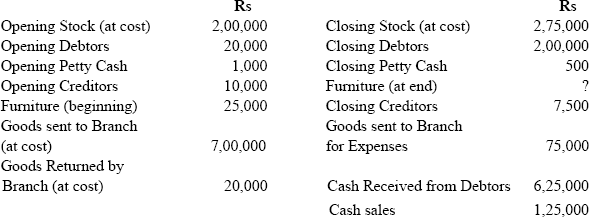
Depreciate the furniture @ 20% p.a.
Solution
Draw the format of Branch Account and transfer the items accordingly.
Jaipur Branch A/c in the Books of Chennai H.O.
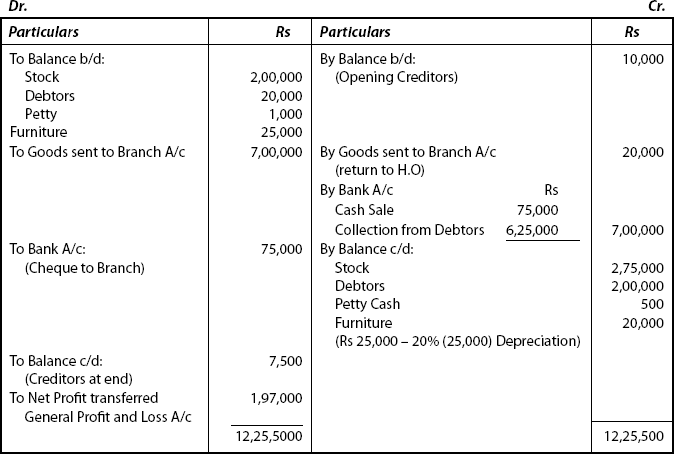
Note:* Deprecation is calculated, deducted and after deduction value of furniture is entered
(Balance c/d) (Credit Side)
Furniture value is entered in the beginning under (Balance b/d Debit Side).
Actual amount of depreciation is not shown in the branch account.
Illustration: 6
From the following information prepare Nagpur Branch Account in the books of Mumbai H.O. for the year ending Mar 31, 2009:
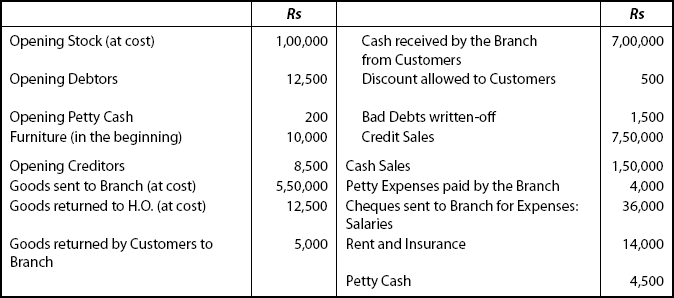
Goods are sold to customers at cost plus 50%. Depreciate the furniture @ 10%
Solution
First the missing figures relating to these items, Closing balances of
- Branch Debtors
- Branch Stock
- Branch Petty Cash and
- Remittances to H.O.
are calculated by preparing respective Memorandum Account
I. Memorandum Branch Debtors Account

II. Memorandum Branch Stock Account

III. Memorandum Branch Petty Cash Account

IV. Memorandum Branch Cash Account

Nagpur Branch Account in the Books of Mumbai H.O.
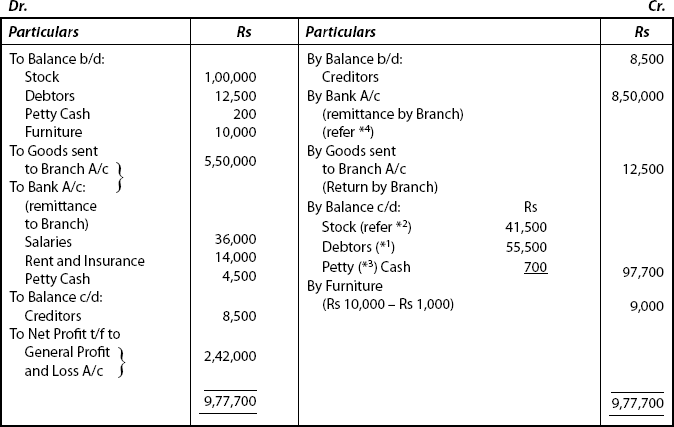
Notes:
- Discount allowed, bad debts written off are not shown in the branch account. However, they will reduce the amount shown as closing debtors. While preparing Memorandum Branch Debtors A/c these items are shown on the credit side which thereby reduces the closing balance figure.
- Depreciation is not shown directly but it was deducted from the furniture.
- Return to branch by customer also reduces Drs balance.
Illustration: 7
A company with its H.O. at Chennai has a branch at Delhi. The branch receives all goods from H.O. which also remits cash for all expenses. Sales are made by the branch on credit as well as for cash. Total sales by the branch for the year ended Mar 31, 2009 amounted to Rs 2,80,000 out of which 20% is cash sale. Further information taken from the branch reveals:
|
|
Apr 1, 2008 |
Mar 31, 2009 |
|
|
Rs |
Rs |
|
Stock in Trade |
12,500 |
18,000 |
|
Debtors |
30,000 |
24,000 |
|
Furniture |
4, 000 |
? |
|
Petty Cash |
60 |
90 |
Expenses actually incurred by the branch during the year were
|
|
Rs |
|
Salaries |
18,000 |
|
Rent |
4,500 (up to Dec 2008) |
|
Petty Expenses |
2,800 |
Sale of furniture on Oct 1, 2008 (book value of furniture on the date of sale Rs 475) amounted to Rs 450.
All sales are made by the branch at cost plus 25%
Depreciation on furniture is 10% p.a.
Prepare Delhi Branch Account in the books of Chennai H.O. For the year ending on Mar 31, 2009.
Solution
Notes: * Goods are sent at cost price.
- Goods have to be adjusted for the load
- Missing figures, cash received from debtors and cash received for petty expenses are to be ascertained by preparing respective Memorandum Accounts.
- Book value of furniture sold and depreciation are to be worked out.
- Based on these figures, branch account prepared according.
Step 1
Calculation of goods sent to branch
|
|
Rs |
|
Cost plus 25% = 100 |
|
|
Load: 25/(100 + 25) = 25/125 or 1/5 |
|
|
Total Sales |
2,80,000 |
|
Less: Load 1/5 × 2,80,000 |
56,000 |
|
|
2,24,000 |
|
Add: Stock at end |
18,000 |
|
|
2,42,000 |
|
Less: Opening Stock |
12,500 |
|
*1 Goods sent to Branch |
2,29,500 |
Step 2: Depreciation
|
|
|
Rs |
|
Book value of furniture as on 1st Oct, 2008 |
= |
Rs 475 |
|
Book value as on 1st Apr, 2008 |
= |
Rs 500 (475× 100/95) |
|
Depreciation on (Rs 4,000 – Rs 500) |
|
|
|
*2 Rs 3,500 for one year @ 10% |
= |
Rs 350 |
|
∴ Furniture at the end |
= |
(Rs 3,500 – Rs 350) |
|
|
= |
Rs 3,150 |
Step 3
Memorandum Branch Debtors Account

Step 4
Memorandum Petty Cash Account

Step 5
Books of Chennai H.O. Delhi Branch Account
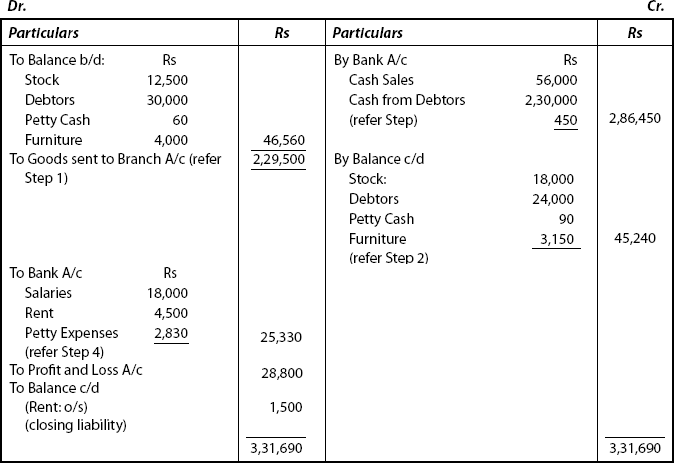
Illustration: 8
Good Luck Co. Chennai has a branch at Lucknow. It invoices goods to the branch at selling price which is cost plus 33⅓%. From the following particulars prepare branch account. (i) At cost price and (ii) At account and goods sent to branch account in the Books of Good Luck Co. Chennai.
|
Rs |
Stock on Jan 1, 2008 (invoice price) |
30,000 |
Debtors on Jan 1, 2008 |
22,800 |
Goods invoiced to branch during the year (at invoice price) |
1,34,000 |
Sales at Branch: |
|
|
|
Rs |
Rs |
|
Cash |
62,000 |
|
|
Credit |
74,800 |
|
|
Cash received from Debtors |
|
1,36,000 |
|
Discount allowed to Customers |
|
80,000 |
|
Bad Debts written off |
|
600 |
|
Cheques sent to Branch: |
|
500 |
|
Salaries |
10,000 |
|
|
Sundry Expenses |
3,400 |
13,400 |
|
Stock on Dec 31, 2008 (at Invoice Price) |
|
26,8000 |
[B.Com (Hons) – Modified]
Solution
Step 1
[Cost Plus = 33 ⅓%
100 + 33 ⅓%
Or
Loading factor = 33 ⅓/100 + 33 ⅓
[i.e. for Sale (or) stock: 33 ⅓/133 ⅓ × stock (or) sale or ¼ × Stock (or) sale]
Step 2
The missing figure, Closing Debtors is calculated as
Memorandum Branch Debtors Account

Step 3: (1) When goods are shown at cost price:
In this account loading has to be removed, i.e. deducted from the cost plus price.
(i) |
For Opening Stock: |
Rs |
|
Invoice Price |
30,000 |
|
[refer Step: 1]Less: (33 ⅓/133 ⅓or ¼ or 25%) [¼ × Rs 30,000] |
7,500 |
|
Cost Price |
22,500 |
(ii) |
For Goods sent to branch: |
|
|
Invoice Price |
1,34,000 |
|
Less: Load (¼ × 1,34,000) |
33,500 |
|
Cost Price |
1,00,500 |
(iii) |
For Closing Stock: |
|
|
Invoice Price |
26,800 |
|
Less: Load (¼ × 26,800) |
6,700 |
|
Cost Price |
20,100 |
Step 4
Books Good Luck Co. Chennai, Lucknow Branch Account

Step 5
When goods are sent at Invoice Price Lucknow Branch Account

* Note the difference in the treatment of “load factor”.
Step 6
Goods sent to Branch Account

Illustration: 9
From the following particular, prepare Noida Branch Account showing profit or loss:
| Opening Stock at the Branch | Rs |
|---|---|
Goods sent to Branch |
37,500 |
Expenses |
1,12,500 |
Salaries |
12,500 |
Rent |
400 |
Other Expenses |
940 |
Sales (cash) |
1,50,000 |
Closing Stock could not be ascertained but it is known that the branch usually sells goods at cost plus 20%. The branch manager entitled to a commission of 5% of profit of branch after charging commission.
[B.com (Hons) – Modified]
Solution
Closing Stock – Missing figure.
It is ascertained by preparing Memorandum Branch Stock Account or by conventional method. Before that load or profit margin is to be computed.
Step 1
Method I
Branch sells goods at cost plus 20% (Given)
Load or Profit Margin = Cost + 20%
= Cost + 20/100 = 20/100 + 20 = 1/6 of Sale Price
Sales = Rs 1,50,000 (Given)
Load = 1/6 – Rs 1,50,000 = Rs 25,000
(i.e. Cost of Sales = Rs 1,50,000 – 25,000 = Rs 1,25,000)
|
|
Rs |
|
|
Sales |
1,50,000 |
|
|
Less: Load |
25,000 |
(1/6th of sale) |
|
Cost of Sales |
1,25,000 |
|
|
Opening Stock |
37,500 |
|
|
Add: Goods sent to Branch |
1,12,500 |
|
|
Total Cost of Goods available for Sale |
1,50,000 |
|
|
Less: Cost Sales |
1,25,000 |
|
|
Value of Closing Stock |
25,000 |
|
Step 2
Method 2
Memorandum Branch Stock Account

Step 3
In Books of Patna H.O., Noida Branch Account

In Books of Patna H.O., Noida Branch Account

Important Notes to Remember
- Calculation of commission to branch manager is to be calculated as follows:
If specifically mentioned:
- Commission as % of net profit before charging commission = (Net profit before commission) × Rate of commission/100
- Commission as % of net profit after charging commission = Net Profit before commission × Rate of commission/100 + Rate of commission
- The following table may be used as a Ready Reckoner for conversion between selling price and cost price (removing load)
(Percentage addition to) Cost Plus To Convert into Selling Price [Proportion (or) % of (sale)] (i) Cost Plus 20% (or 1/5)
20/100 + 20 = 20/120 = 1/6 (or) 16 2/3%
(ii) Cost Plus 25% (or 1/4)
25/100 + 25 = 25/125 = 1/5 (or) 20%
(iii) Cost Plus 331/3% (or 1/3)
33 1/3 / 100 + 33 1/3 = 100/3/400/3 = 1/4 (or) 25%
(iv) Cost Plus 50% (or 1/2)
50/100 + 50 = 50/150 = 1/3 or 33 1/3%
-
- Unless and otherwise stated, goods sent to branch and branch stocks are treated at their invoice price.
- Once again remember: “Invoices goods at a price” denotes invoice price and the difference between invoice price and cost price is termed as load or profit margin or mark up.
Illustration: 10
Swastika Ltd. of Shimla has a branch at Cochin. Goods are invoiced to the branch at cost plus 25%. The branch does not maintain account books and all collection at the branch are remitted to H.O. The expenses of the branch are remitted to H.O. The expenses of the branch are reimbursed by the office. From the following particulars, prepare the branch account in the books of H.O. for six months ending on Sep 30, 2008.
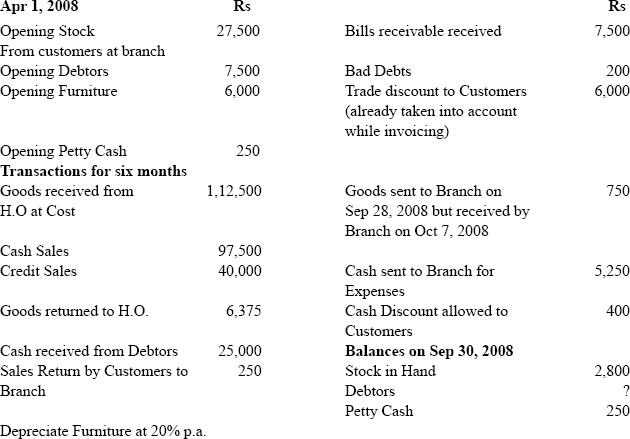
Branch manager is entitled to a commission of 5% of profit of the branch after charging such commission.
Solution
Step 1: |
Closing debtors is a missing figure. To ascertain it, Memorandum Branch Debtors Account is to be prepared. |
Memorandum Branch Debtors Account
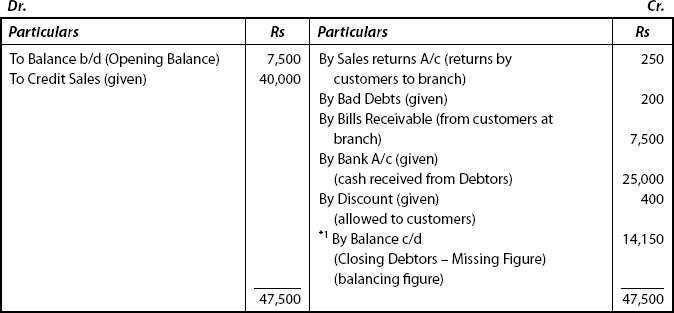
Books of Swastik Ltd Shimla H.O
Cochin Branch Account
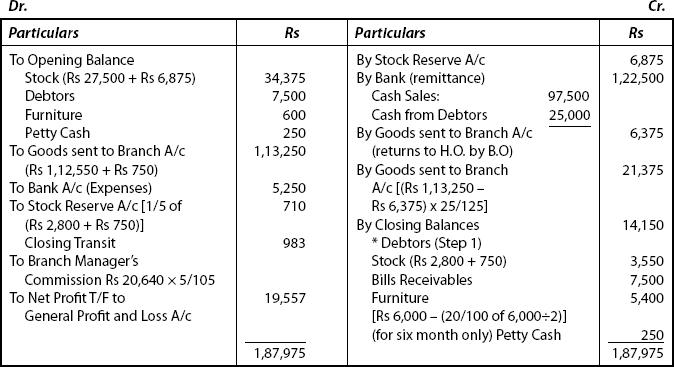
Illustration: 11
From the following details relating to Delhi Branch for the year ending Mar 31, 2009, prepare the branch account in the books of Surat H.O.
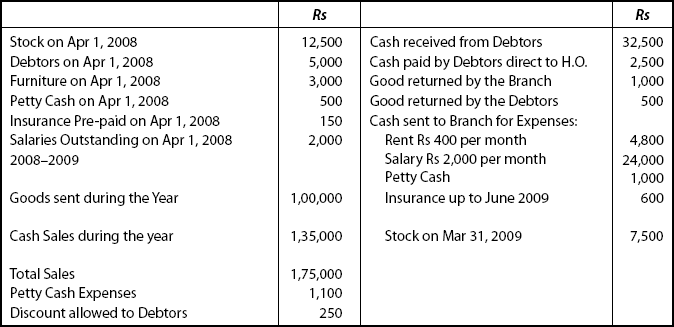
Goods costing Rs 1,250 were damaged in transit and a sum of Rs 1,000 was recovered from the insurance company in full settlement of the claim. Depreciation on furniture @ 10% p.a.
Solution
- Goods in transit are damaged
- Insurance claim is recovered
- Closing balances are missing for
- Debtors
- Petty Cash
Step 1
Memorandum Branch Debtor Account

Step 2
Memorandum Petty Cash Account

Step 3
Delhi Branch Account for the Year Ending Mar 31, 2009
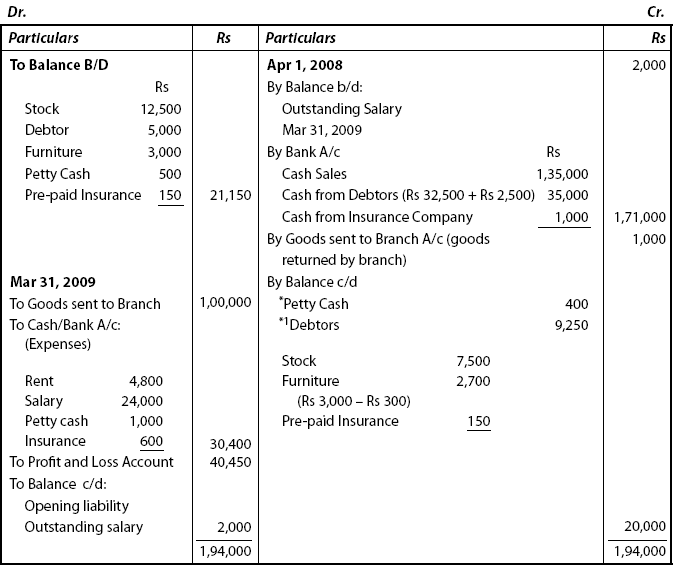
*Only the settlement amount received from the insurance company is credited under Cash A/c head in the branch account.
*In this problem, calculations relating to load factor do not arise, as the question is silent on this aspect.
Illustration: 12
Mrs. Shree opened a hosiery company, dealing in inner garments in Tiruppur, Tamil Nadu and has opened several branch shops at Chennai, Mumbai, Kolkatta and Delhi. All the purchasing and administration is done at Tiruppur Tamil Nadu H.O. only. Branches sell goods both for cash and on credit terms. The branches are expected to make a profit of 25% on cost price to H.O. The following information relates to Delhi Branch for the year ending on Mar 31, 2009.
|
|
Rs |
|
Opening Stock of Goods (at cost to H.O.) |
1,12,000 |
|
Opening Debtors |
40,000 |
|
Goods received by Branch at Selling Price |
7,50,000 |
|
Transfer from Chennai Branch at Selling Price |
30,000 |
|
Cash Sales |
7,10,000 |
|
Credit Sales |
1,50,000 |
|
Goods returned to Mumbai Branch at Selling Price |
30,000 |
|
Debtors at the End |
52,000 |
|
Bad Debts written off |
5,000 |
|
Goods returned by Credit Customers of |
3,000 |
|
Delhi Branch direct to Tiruppur H.O. |
|
|
Expenses at the Branch |
96,000 |
|
Normal Pilferage at Selling Price |
10,400 |
Additional Information
- Goods amounting to Rs 20,000 at cost of H.O. reached Delhi Branch on Apr 3, 2009.
- Delhi Branch had on Apr 1, 2008 laptop and other accessories at a book value of Rs 1,50,000. Depreciation at 10% p.a. is to be provided on this.
You are required to prepare
- Branch Stock Account
- Branch Debtors Account
- Delhi Branch Account to find out the profit or loss at Delhi Branch
Solution
- From the additional information, it is learnt that goods amounting to Rs 20,000 was in transit, as these were received by the branch after Mar 31, 2009. It has to be shown as closing stock balance.
- One more item, i.e. pilferage appears in this question. It is to be treated as normal loss and shown in the Branch Stock Account. Accordingly, closing stock balance will be reduced to that extent in the Delhi Branch Account.
(i) In the Books of Shree, Delhi Branch Stock Account
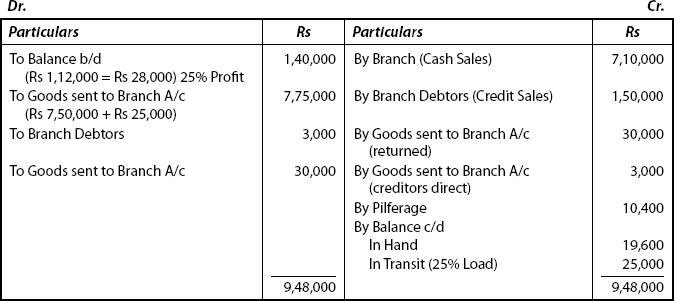
(ii) Branch Debtors Account

(iii) Delhi Branch Account
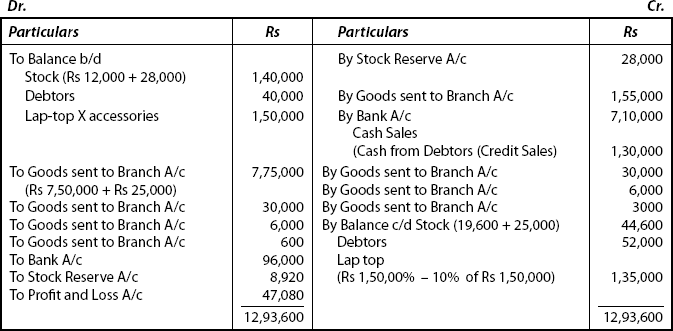
Illustration: 13
Kolkata H.O. of a company invoices goods to its Nagpur Branch at cost plus 20%. The branch purchases goods from local sources also for which payments are made by the H.O. All cash collected by the branch is banked on the same day to the credit of the H.O. except for a petty cash account maintained by the branch for which periodic transfers are made from the H.O.
From the following particulars, show branch account as maintained by the H.O. showing the profit for the year ended Mar 31, 2009.
|
Imprest Cash: |
Rs |
|
On Apr 1, 2008 |
4,000 |
|
On Mar 31, 2009 |
3,700 |
|
Debtors on Apr 1, 2008 |
50,000 |
|
Stock on Apr 1, 2008: |
|
|
(i) Transferred from H.O. at Invoice Price |
48,000 |
|
(ii) Direct purchases made by the Branch |
32,000 |
|
During 2008–2009: |
Rs |
|
Cash Sales |
90,000 |
|
Credit Sales |
2,60,000 |
|
Direct Purchases made by the Branch |
90,000 |
|
Goods returned by Customers |
6,000 |
|
Goods sent to Branch from H.O. at Invoice Price |
1,20,000 |
|
Goods transferred to Branch from H.O. for petty Cash expenses |
5,000 |
|
Bad Debts |
2,000 |
|
Discount allowed to Customers |
4,000 |
|
Cash received from Customer |
2,50,000 |
|
Branch Expenses |
60,000 |
|
Stock on Mar 31, 2009: |
|
|
(i) Transferred from H.O. at Invoice Price |
36,000 |
|
(ii) Direct Purchases made by the Branch |
24,000 |
B.Com (Hons). Modified
Solution
Note: In this question, transactions relating to direct purchases by the branch is provided for this, they are shown separately – opening stock, purchase, closing stock-but along with the transactions relating to H.O.
The missing figure is – closing debtors. It is to be ascertained by preparing Memorandum Debtors Account.
Step 1
Memorandum Debtors Account

Step 2
In the Books of Kolkata H.O., Nagpur Branch Account

Illustration: 14
Guber Ltd. has a H.O. at Chennai and retail branches across the country which are supplied goods from the H.O. at 20% profit on sale price. Accounts are kept at H.O. from where all expenses (except petty) are paid. Petty expenses are paid by the branches that are allowed to maintain petty cash balance of Rs 600 on Imp rest system. From the following balances, as shown by the books, prepare branch account.
|
Balances on Jan 1, 2008 |
Rs |
|
Petty Cash in Hand at Branch |
600 |
|
Stock in Hand at Branch at Sales Price |
40,000 |
|
Sundry Debtors |
8,000 |
|
Sundry Creditors |
2,400 |
|
Furniture |
16,000 |
|
Rent paid up to Mar 31, 2008 |
600 |
|
Transactions during the year 2008: |
|
|
Goods sent to Branch (Less: return) |
2,08,000 |
|
Cash Sales at Branch |
1,60,000 |
|
Credit Sales at Branch |
90,000 |
|
Allowances to Debtors |
1,000 |
|
Cash received from Customers |
80,000 |
|
Bad debts to be written off |
400 |
|
Cash Purchases by the Branch (with permission) |
21,000 |
|
Cash paid to Creditors |
16,000 |
|
Creditors at the end |
6,000 |
|
Payment by Branch Petty Expenses |
360 |
|
Payment made by H.O. |
|
|
Rent for one year (paid) on Apr 1, 2008 |
3,600 |
|
Salaries |
4,000 |
|
Insurance paid for the year ending Mar 31, 2009 |
720 |
|
Balance on Dec 31, 2008 |
|
|
Stock at Cost |
60,000 |
|
Write off 10% Depreciation on Furniture |
|
Solution
Note:
- Petty cash system is maintained by imp rest system. As such expenses spent will be reimbursed by the H.O.
- Credit transactions (credit purchase and credit sales) usually are not shown in the branch account. But such transactions are shown in Creditors Account and Debtors Account, respectively.
- Similarly, cash purchases and cash sales are not directly shown in the branch account. But these are considered in arriving at cash balance (cash account).
- So, Memorandum Debtors Account, Creditors Account Cash Account and Petty Cash Account are prepared to arrive at figures.
Step 1
Cash Account

Step 2
Petty Cash Account

Step 3
Creditors Account

Step 4
Debtors Account

Step 5
Branch Account

OBJECTIVE 5: STOCK-DEBTORS SYSTEM OR STOCK AND DEBTORS METHOD
5.1 Meaning of Stock-Debtors System
The method, discussed so far, i.e. debtors system discloses only the final figures of stock. It does not show normal or abnormal loss. It does not reveal gross profit and net profit separately. It lacks control of new stock. To overcome such drawbacks, this system known as Stock and Debtors System is employed.
5.2 Different Accounts and their Purpose
Under Stock and Debtors System an elaborate accounting procedure is followed which comprises a number of accounts for each branch such as
- Branch Stock Account, to ascertain any shortage or surplus in stock
- Branch Debtors Account to ascertain the closing debtors
- Branch Expenses Account to compute the total expenses at a branch
- Branch Adjustment Account to compute gross profit or loss
- Branch Profit and Loss A/c to compute net profit or loss
- Goods sent to Branch A/c to find the net cost of goods sent to branch
- Branch Cash A/c to show all cash transactions of a branch
- Branch Fixed Assets A/c to record fixed assets transactions
5.3 Branch Stock Account
- It is a real account.
- Under Stock and Debtors System, branch account is always prepared at INVOICE PRICE, i.e. Cost Plus Profit Margin.
- If any item is given other than at invoice price, all such items must be converted into invoice price.
- All items are entered at uniform amounts in terms of invoice price, i.e. loaded or cost plus margin
- When all items relating to branch account (opening stock, goods returned by customers to the branch as well as directly by the branch goods returned by customers to the branch as well as direct to H.O. goods returned by the branch to H.O. cash sales and credit sales; normal and abnormal loss) are converted into invoice price and entered, then the total of both the credit and debits side will TALLY.
- In case, if the debit side total exceeds the credit side total, the difference is entered as “shortage” in the credit side.
In case, if the credit side total exceeds the debit side total, the difference is entered as “Surplus” in the debit side of the Branch Stock Account.
5.4 Branch Adjustment Account
- This is a Nominal Account.
- It is similar to Trading and Profit and Loss Account.
- In this account, Gross Profit is ascertained first as:
Debit:
- Stock reserve A/c (load of the stock at end) in Branch Stock A/c
- Load of the “Shortage” in Branch Stock A/c
- Load on goods returned to H.O.
Credit:
- Stock reserve A/c (load of the stock in the opening)
- Load or the goods invoiced to branch
- “Surplus” in the Branch Stock A/c
Result: Gross profit: If the credit side total exceeds the (or) debit side total.
Gross Loss: If the debit side total exceeds the credit side total.
The Gross Profit or Loss is transferred to the next part of Branch Adjustment Account.
Gross Profit is carried down to the credit side and Gross Loss is carried down to the debit side and Further
Debit:
- Balance in the Branch Expenses Account
- Cost elements of shortage and loss
Credit:
- Claim received from insurance company
- Any claim received relating to abnormal loss
The difference in two sides may be net profit or net loss.
5.5 Branch Expenses
All the expenses spent for the branch by the H.O. are recorded as one single figure and debited to this A/c. The balance in this account is transferred (to compute the net profit/loss) to Branch Adjustment Account.
5.6 Stock Reserve Account
As stock is not shown at its loaded price in Balance Sheet, this account has to be prepared. Goods sent to branch account: To ascertain the cost of goods sent and to compute gross profit, this account is prepared.
5.7 Accounting Treatment
Journal Entries
| Transaction | Journal Entry | ||||||||||||||||||||||||||||||||||||||||||||||||||||||||||||||||||||||||||||||||||||||||||||||||||||||||||||||||||||||||
|---|---|---|---|---|---|---|---|---|---|---|---|---|---|---|---|---|---|---|---|---|---|---|---|---|---|---|---|---|---|---|---|---|---|---|---|---|---|---|---|---|---|---|---|---|---|---|---|---|---|---|---|---|---|---|---|---|---|---|---|---|---|---|---|---|---|---|---|---|---|---|---|---|---|---|---|---|---|---|---|---|---|---|---|---|---|---|---|---|---|---|---|---|---|---|---|---|---|---|---|---|---|---|---|---|---|---|---|---|---|---|---|---|---|---|---|---|---|---|---|---|---|
|
|
Proforma Branch Stock Account at Invoice Price

Illustration: 15
VRV Ltd., Delhi has a branch in Chennai to which goods are sent @ 20% above cost. The branch sells goods at cash and credit basis. Branch expenses are met partly from H.O. and partly by the branch. Following further details are given for the year ending on Dec 31, 2008.
|
|
Rs |
|
Cost of Goods sent to Branch at cost |
1,00,000 |
|
Goods received by Branch at Invoice Price |
1,10,000 |
|
Credit Sales for the year at Invoice Price |
82,000 |
|
Cash Sales for the year at Invoice Price |
29,000 |
|
Cash remitted to H.O. |
1,11,250 |
|
Expenses paid by H.O. |
6,000 |
|
Bad Debts written off |
375 |
|
Balances as on |
|
|
|
Jan 1, 2008 |
Dec 31, 2008 |
|
|
Rs |
Rs |
|
Stock |
12,500 (cost) |
14,000 (Invoice Price) |
|
Debtors |
16,375 |
13,000 |
|
Cash in Hand |
2,500 |
1,250 |
Show necessary ledger accounts in the books of H.O. and calculate the profit and loss of the branch for the year ended Dec 31, 2008 under:
- Debtors Method
- Stock and Debtors Method
Solution: Stage I
Step 1: Debtors Method
In the Books of VRV Ltd., Delhi, Chennai Branch Account

Step 2
Memorandum Branch Stock Account

Step 3
Memorandum Branch Debtors Account

Step 4
Memorandum Branch Cash Account

Stage II: Stock and Debtors Method
Step 1
Branch Stock Account

Notes:
- Figures already given at Invoice Price entered as it is.
- Figures that are not at Invoice Price are converted to Invoice Price and entered.
- Only Invoice Price should be entered under Stock and Debtors System (always).
Step 2
Branch Debtors Account

Step 3
Branch Cash Account

Step 4
Branch Adjustment Account
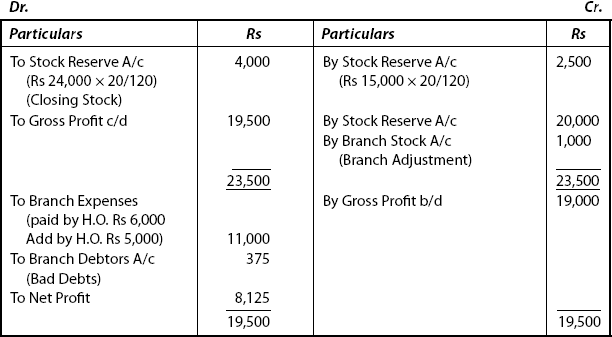
Step 5
Goods sent to Branch Account

Note: Branch Adjustment Account is treated here, just as in Trading and Profit and Loss Account, i.e. Gross Profit is ascertained first and then the same account is continued by transferring Gross Profit (arrived at) to the credit side and Net Profit is ascertained.
Sometimes, Branch Adjustment Account is closed after ascertaining Gross Profit. Then Branch Profit and Loss Account is opened and Net Profit/Loss is ascertained from that account.
Students can adopt either of these two methods.
Illustration: 16
Renu of Chennai has a branch in Delhi. Goods sent to the branch are invoiced at selling price, i.e. cost plus 33⅓%. From the following particulars, you are required to prepare the Branch Stock Account and Branch Adjustment Account as they would appear in the books of the H.O.
|
|
Rs |
|
Stock on Apr 1, 2008 |
60,000 |
|
Stock on Mar 31, 2009 |
48,000 |
|
Goods sent to Delhi during 2008–2009 |
4,00,000 |
|
At Invoice Price |
|
|
Sales at Branch |
|
|
On Credit |
1,28,000 |
|
On Cash |
3,00,000 |
|
Returns to H.O. at Invoice Price |
20,000 |
|
Invoice value of goods lost by fire, not covered by Insurance |
4,000 |
(B.Com. – Modified)
Solution
In the Books of Chennai H.O. Delhi Branch A/c
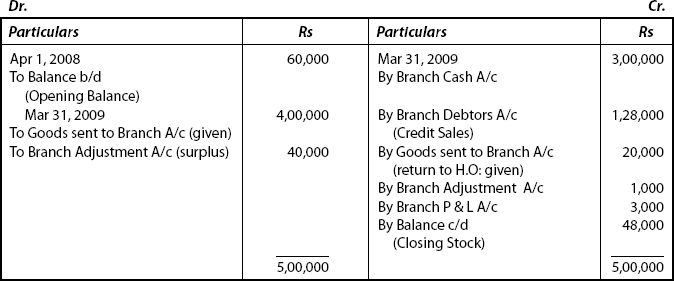
Books of Chennai H.O. Delhi Branch Adjustment A/c

Illustration: 17
Mr. Khan has a retail branch at Vijayawada. Goods are sent by the H.O. to the branch market at selling price which is cost plus 25%. All expenses of the branch are paid by the H.O. All cash collected by the branch (from customers and from cash sales) is deposited to the credit of H.O. From the following particulars of the branch, prepare Branch Stock Account, Branch Debtors Account, Branch Expenses Account and Branch Adjustment Account in the books of H.O.
|
|
Rs |
|
Debtors on Jan 1, 2008 |
36,000 |
|
Debtors on Dec 31, 2009 |
42,000 |
|
Inventory with the Branch at Invoice Price: |
|
|
On Jan 1, 2008 |
48,000 |
|
On Dec 31, 2009 |
51,000 |
|
Cash Sales during the year |
1,80,000 |
|
Total Amount deposited in the H.O. Account during the year |
3,81,000 |
|
Returned Goods to H.O. at Invoice Price |
15,000 |
|
Salaries Paid |
18,000 |
|
Rent Paid |
12,000 |
|
Discount allowed to Customers |
6,000 |
|
Bad Debts written off |
3,000 |
|
Spoilage |
6,000 |
[B.Com. (Hons) – Modified]
Solution
Notes:
- Goods sent to branch is the missing figure. It can be ascertained by preparing Branch Stock A/c.
- Credit sales have to be ascertained after making adjustments in Branch Debtors Account. To compute that figure, first Branch Debtors Account is prepared.
Step 1
Vijayawada Branch Debtors Account
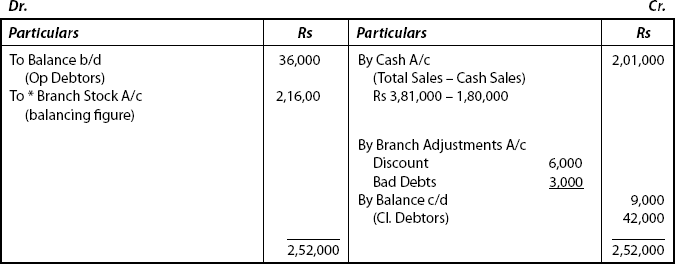
Step 2
Vijaywada Branch Stock Account

Step 3
Vijayawada Branch Adjustment Account for the Year Ending on Dec 31, 2008
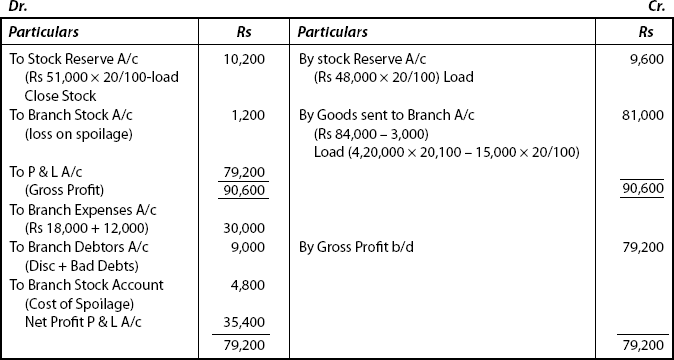
Illustration: 18
Good Wear Garments sent goods to Kolkata Branch at cost plus 25%.
Further Information
|
|
Rs |
|
Opening Stock at Branch at its Cost |
25,000 |
|
Goods sent to Branch at its Invoice Price |
1,00,000 |
|
Loss in Transit at Invoice Price |
12,500 |
|
Theft (at Invoice Price) |
5,000 |
|
Loss in Goods (normal) at Invoice Price |
2,500 |
|
Sales |
1,27,500 |
|
Expenses |
40,000 |
|
Closing Stock at Branch at Cost to Branch |
30,000 |
|
Claims received from the Insurance Company for Loss in Transit |
10,000 |
Show
- Branch Stock Account
- Branch Adjustment Account
- Branch Profit and Loss Account
Solution
Notes: In this question, both normal loss and abnormal loss are provided.
- Normal loss will not be split into (1) Load and (2) Cost of the goods lost (already shown in the previous illustration). As normal loss affects gross profit only, it is treated in the Branch Adjustment Account accordingly.
- Abnormal loss will be split into load and cost of the goods lost and as it affects both gross profit and net profit it is treated as:
- Load will be adjusted in the determination of gross profit
- After ascertaining gross profit, the cost of goods lost will be adjusted in determining net profit.
Notes: Regarding Branch Stock Account, accounting treatment is same for both normal and abnormal loss. But the load is shown by debiting Branch Adjustment Account and the cost of the goods lost is shown by debiting Branch Profit and Loss A/c separately but both on the credit side of the branch account.
Claim received from insurance company is debited to insurance company and directly shown in Net Profit and Loss A/c (on the credit side).
Step 1
In the Books of Good Wear Garments Kolkata Branch Stock Account

Step 2
Kolkata Branch Adjustment Account for the Year ending on…
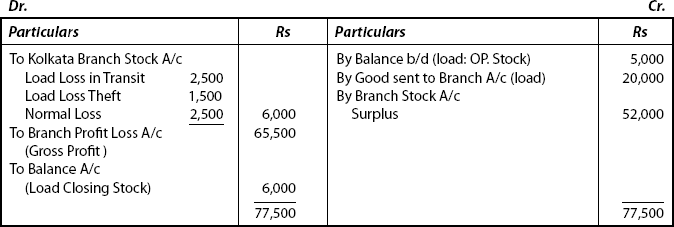
Step 3
Branch Profit & and Loss Account

Note: As separate profit and loss account is asked in the question, it is shown separately.
Illustration: 19
VRV Ltd. invoices goods to its branch at cost plus 33?%. From the following particulars prepare the Branch Account, Branch Stock Adjustment Account and Branch Profit and Loss Account as they would appear in the books of the H.O.
|
|
Rs |
|
Stock in Hand (opening) at the Branch |
75,000 |
|
Stock in Hand (closing) at the Branch |
60,000 |
|
Goods sent to Branch (including goods) |
5,00,000 |
|
Invoiced at Rs 10,000 to branch on Mar |
31, 2009 |
|
(Not received before the close of year) |
|
|
(It closed its books on Mar 31, 2009) |
|
|
Return of Goods to H.O. |
25,000 |
|
Credit Sales at Branch |
1,90,000 |
|
Invoice valued of goods pilfered |
5,000 |
|
Normal Loss at Branch due to Wastage and determination of Stock at Invoice Value |
7,500 |
|
Cash Sales at Branch 60% of Net Sales |
|
Solution
The following factors are to be taken into note
- Goods in transit (goods are despatched but not received yet)
- Normal loss is given as Rs 7,500 (wastage, etc.)
- Abnormal loss is shown as Rs 5,000 (pilferage)
- “Surplus” is to be treated, i.e. from Branch Stock A/c it has to be taken to Branch Adjustment A/c to ascertain Gross Profit.
Step 1
Branch Stock Account
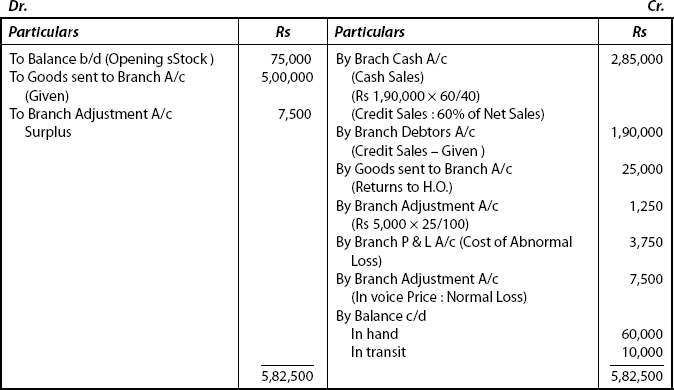
Step 2
Branch Adjustment Account

Step 3
Branch Profit and Loss Account

Illustration: 20
Mr. Raj having a H.O. at Chennai, opened several branches at Mumbai, Delhi, Kolkata and Cochin. All the purchasing and administration is done at the H.O. Branches were also allowed to purchase locally. Branches sell both for cash and on credit terms, but all invoices for credit sales are invoices from Chennai and payments from credit customers received there. The branches are expected to achieve a profit of 50% on cost price. The following details relate to the Delhi Branch for the first six months of 2009.
|
|
Rs |
|
Goods as on Jan 1, 2009 at branch at Cost Price |
28,000 |
|
Debtors as on Jan 1, 2009 at branch |
9,000 |
|
Goods received by the branch at Selling Price |
1,80,000 |
|
Cash Sales |
1,02,000 |
|
Credit Sales |
60,000 |
|
Transfer from other branches to Delhi branch at Selling Price |
12,000 |
|
Transfer to other branches to Delhi branch at Selling Price |
21,000 |
|
Goods returned to H.O. at Selling Price |
6,000 |
|
Cash received by H.O. from Debtors |
53,000 |
|
Bad Debts written off |
2,000 |
|
Goods returned by Credit Customers to Branch |
2,400 |
|
Goods returned by Credit Customers to H.O. |
1,200 |
|
Goods purchased by Delhi Branch from the Local Suppliers at cost |
15,000 |
|
7,500 |
|
|
Stock as on June 30, 2009 at Delhi Branch |
|
|
From H.O. at Selling Price |
45,000 |
|
From Goods purchased locally |
3,000 |
Further Information
- Goods amounting to Rs 6,000 at cost to H.O. were in transit.
- On Jan 1, 2009, the branch had furniture and fixtures at a book value of Rs 20,000. Depreciation at 10% is to be provided per annum.
- Goods purchased locally were sold at a profit of 25% on sale price.
Prepare Branch Stock Account, Branch Debtors Account and Delhi Branch Account.
Solution
Step 1
Delhi Branch Stock Account

Step 2
Delhi Branch Stock Account

Step 3
Delhi Branch Account

Illustration: 21
Rainbow & Co. a retail shop at Agra under the supervision of a manager. The ratio of gross profit sales is constant at 25% throughout the year to March 31, 2009.
Branch manager is entitled to a commission of 10% of profit earned by his branch, calculated before charging his commission but subject to a deduction from such commission equal to 25% of any ascertained deficiency of branch stock. All goods were supplied to the branch by the H.O.
From the following information, show the Agra Branch A/c for the year ending Mar 31, 2008–2009.
|
|
Rs |
|
Stock on Apr 1, 2008 (at cost) |
18,684 |
|
Goods sent to Branch (at cost) |
72,420 |
|
Sales |
90,320 |
|
Manager’s Commission paid on Account |
600 |
|
Chargeable Expenses |
12,280 |
|
Stock at the End (at Selling Price) |
30,832 |
Solution
Agra Branch Account for the year ending on Mar 31, 2009

Shortage or Stock deficiency is computed by Preparing Stock A/c at the loaded price Branch Stock A/c

Deficiency to be charged to manager = (Rs 320 × 75/100) × 25/100 = Rs 60
Working Notes
|
|
Rs |
|
Calculation of Manager’s Commission |
10,060 |
|
Net Profit arrived at before charging Commission |
1,006 |
|
10% of the profit before charging Commission |
60 |
|
Less: 25% of Stock Deficiency |
___ |
| Commission for 2008 2009 |
946 |
|
Less: Paid during the year |
600 |
|
Commission yet to be paid |
346 |
Illustration: 22
Fortune Ltd. with its H.O. in Goa invoiced goods to its branch Bhubaneswar at 20% less than the catalogue price which is cost plus 50% with instructions that cash sales were to be made at invoice price and credit sales at catalogue price less discount at 15% on prompt payment. From the following particulars, prepare Branch Stock Account, Branch Adjustment Account and Branch Profit and Loss Account for the year ended Mar 31, 2009 in the H.O. Books.
|
|
Rs |
|
Stock on Apr 1, 2008 (Invoice Price) |
24,000 |
|
Debtors received Apr 1, 2008 |
20,000 |
|
Goods received from (H.O) at Invoice Price |
2,64,000 |
|
Sales (Cash) |
92,000 |
|
Sales (Credit) |
2,00,000 |
|
Cash received from Debtors |
1,71,270 |
|
Discount allowed to Debtors |
26,730 |
|
Expenses at the Branch |
12,000 |
|
Remittances to H.O. |
2,40,000 |
|
Debtors on Mar 31, 2009 |
22,000 |
|
Cash in Hand on Mar 31, 2009 |
11,270 |
|
Stock on Mar 31, 2009 |
30,000 |
It was further provided that a part of the stock was lost by fire (not covered by insurance) during the year whose value is to be ascertained and a provision should be made for discount to be allowed to debtors as on Mar 31, 2009, on the basis of year’s trend of prompt payment.
[B.Com (Hons) – Modified]
Solution
Step 1: Sales are made at more than Invoice Price
Let Cost Price be Rs 100
Invoice Price is 20% less than catalogue price
But, Catalogue Price is Cost Plus 50%
i.e. Catalogue Price is Rs 100 + Rs 50 = Rs 150
i.e. Invoice Price = [Rs 150 – (20% of Rs 150)]
= Rs 150 – Rs 30 = Rs 120
Step 2: Calculation of Provision for Discount on Debtors: Rs 26,730
Total amounts of debtors who made payments during the year = (Rs 171,270 + Rs 26,730)
= Rs 1,98,000
On debtors of Rs 1,98,000 discount paid is Rs 26,730
i.e. On debtors of ![]()
discount to be allowed
Provision for Discount on Debtors for 2008–2009 = Rs 2,970
Step 3
Bhubaneswar Branch Stock Account

Step 4
Bhubaneswar Branch Stock Account

Step 5
Bhubaneswar Branch Profit and Loss Account for the year ending on Mar 31, 2009
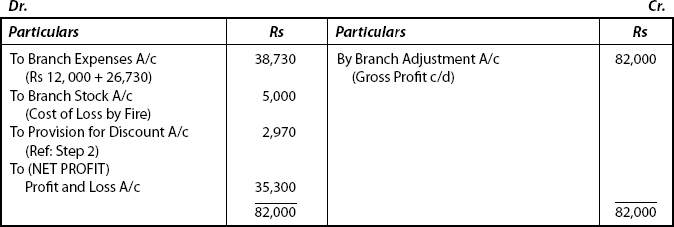
5.8 Final Account System
- Profit or loss at the branch is calculated by preparing Trading and Profit and Loss Account in the place of branch account under this method.
- Under this method branch account is also prepared but it is different from the branch account that we discussed under Debtors System.
- According to this method, branch account is only personal account.
5.9 Items to be Shown in the Branch Account
Under this method, the following items are shown on the debit side of branch account:
5.9.1 Final Account System
- Balances of all assets in the beginning
- Goods sent to Branch Less Returns (at cost price)
- Cash sent to branch by H.O. for expenses
- Profit (transferred from Branch Trading and Profit and Loss Account)
- Balance of all liabilities at the end
5.9.2 Items to be Recorded in the Branch Account under Final Account System
The following items are shown on the credit side of the branch account:
- Balances of all liabilities in the beginning
- Cash remitted to H.O.
- Loss (transferred from Branch Trading and Profit and Loss Account)
- Balance of all assets at the end
Illustration: 23
A Surat merchant has a branch at Tiruchirapalli (TN) to which charges the goods at cost plus 25%. The Tiruchirapalli Branch keeps its own sales ledger and transmits all cash received to the H.O. every day. All expenses are paid from the H.O. The transactions were as follows:
|
|
Rs |
|
Stock on Apr 1, 2009 |
80,000 |
|
Debtors on Apr 1, 2008 |
800 |
|
|
Rs |
|
Petty Cash |
800 |
|
Cash Sales |
20,800 |
|
Goods sent to Branch |
1,40,000 |
|
Collections from Ledger Account |
1,52,000 |
|
Goods returned to H.O. |
2,000 |
|
Bad Debts |
1,600 |
|
Allowances to Customers |
1,400 |
|
Return Inwards |
3,000 |
|
Cheques sent to Branch: |
|
|
Rent |
4,000 |
|
Salaries |
8,000 |
|
Stock as on Mar 31, 2009 |
1,00,000 |
|
Debtors as on Mar 31, 2009 |
14,000 |
|
Petty Cash (including Miscellaneous Income Rs 200 not remitted on Mar 31, 2009) |
600 |
Prepare the Branch Trading and Profit and Loss Account for the year ending on Mar 31, 2009 and the branch accounts in the books of the H.O.
Solution
Step 1
In the Books of Surat H.O. Tiruchirapalli Branch Trading and Profit and Loss A/c for the year ending Mar 31, 2009
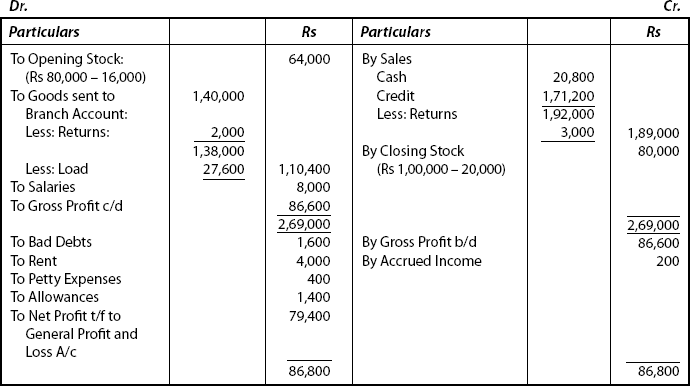
Step 2
Branch Account

Illustration: 24
Jagannath Steels Ltd with its H.O. at Cuttack has a branch at Delhi. Information relating to Delhi branch is furnished for the year ended Mar 31, 2009.
|
|
Rs |
|
Stock at Branch on Apr 1, 2008 |
1,57,000 |
|
Goods sent to the Branch during the year |
4,56,000 |
|
Total Sales at Branch (including Rs 1,97,000) for Cash Sales |
7,33,000 |
|
Cash received from Debtors |
5,22,000 |
|
Branch Debtors on Apr 1, 2008 |
1,69,000 |
|
Petty Cash on Apr 1, 2008 |
1,100 |
|
Goods returned by the Expenses: |
39,000 |
|
Salary |
1,28,000 |
|
Petty Cash |
26,000 |
|
Rent |
30,000 |
|
Stock at Branch on Mar 31, 2009 |
1,88,000 |
|
Petty cash at Branch on Mar 31, 2009 |
900 |
Prepare a Branch Trading and Profit and Loss Account and Delhi Branch Account in the books of Cuttack H.O.
Solution
Step 1
In the Books of Cuttack H.O. Delhi Branch Trading and Profit and Loss Account for the year ending on Mar 31, 2009
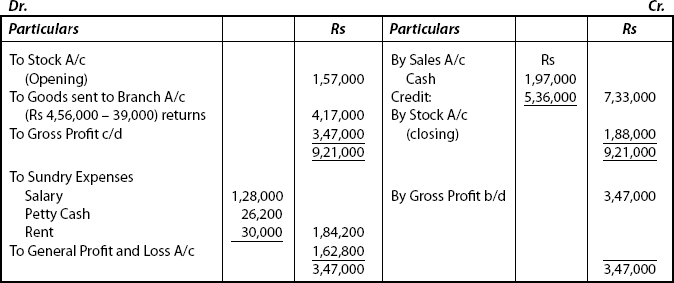
Step 2
Memorandum Branch Debtors Account

Step 3
Delhi Branch Account
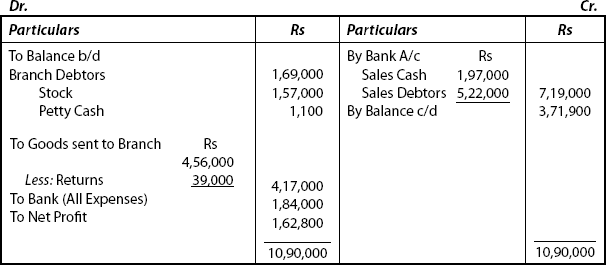
Illustration: 25
A Delhi merchant opens a branch in Chennai which trades independently of the H.O. The transactions of the branch for the year ended Mar 31, 2009 are as follows.
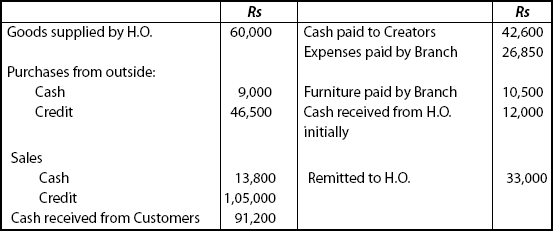
Prepare the Branch Trading and Profit and Loss Account after and Branch Account after taking into account the following:
- The accounts of fixed assets are maintained in H.O. Books
- Write off Depreciation on Furniture @ 20% p.a.
- A remittance of Rs 6,000 from the branch to H.O. is in transit
- The branch closing stock is valued at Rs 36,000
Solution
Step 1
In the Books of Delhi H.O.
(1) Chennai Branch Trading and Profit and Loss Account for the Year ended on March 31, 2009

Step 2
Memorandum Chennai Branch Cash Account
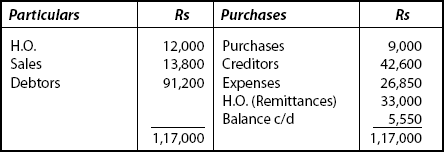
Step 3
Memorandum Chennai Branch Debtors Account

Step 4
Memorandum Chennai Branch Creditors Account

Step 5
Chennai Branch Account

5.10 Wholesale Branch Method
- Under this system, the H.O. supplies goods to the wholesalers and sells them through retail branches also.
- Goods are supplied at the same price to both these categories.
- The retail branches will sell the goods at catalogue price that is higher than the wholesale price.
- The difference between the retail price and wholesale price is called “additional profit.”
- This factor “additional profit” plays a key role in determining the profit by opening a branch by the H.O. To put it other way, the additional profit (to be earned by opening a branch) is assessed by the H.O. whether by opening a branch can earn more profit.
- This method provides an answer to this question.
5.10.1 Accounting Treatment
Under this method also, Branch Trading and Profit and Loss Account is prepared. But the treatment for stock differs here. (The difference between wholesale price and its cost to H.O.). Load factor is the important component to be in the stock under head stock Reserve A/c.
The relationship between cost, wholesale profit and retail profit may be presented in the form of equation as follows:
- Wholesale Profit = Wholesale Price – Cost
- Retail Profit = Retail Price – Wholesale Price
Profit made by the H.O. may be explained by way of illustrations by employing this method – “Wholesale Branch Method.”
Illustration: 26
|
|
Rs |
|
Opening Stock at a Branch |
1,80,000 |
|
Goods sent to Branch |
13,20,000 |
|
Sales at the Branch |
13,20,000 |
Compute the value of closing stock at the branch in each of the following alternatives:
Case (1) |
If H.O. invoices goods to its branch at cost plus 25% goods sold to customers at cost plus 100%. |
Case (2) |
If the H.O. invoices goods to its branch at 20% less than the list price which is cost plus 100%. |
Case (3) |
If the H.O. sends goods at cost plus 20%. Branch sells goods at list price which is wholesale price plus 10%. |
Solution
Step 1: First understand the terms: |
List Price |
|
Catalogue Price |
|
Retail Price |
|
↓ |
|
All denotes the same meaning |
Step 2: Second, know the Invoice Price
if it is shown as cost plus….% + Rs 100 + …..% = ….Amount
sells the goods at cost plus 100% means = Rs 100 + Rs 100
Step 3: It can be best explained by taking case (1) first
Let Cost Price be taken as |
Rs 100 |
(Assumption) |
Add: Wholesale Profit |
25 |
(Invoice Cost plus 25% 100 + Rs 25) |
Wholesale Price |
125 |
|
Add: Retail Profit |
? |
|
List Price/Retail Price = Rs 200, i.e. sold = cost plus 100% (Rs 100 + Rs 100) = Rs 200
From the relationship equation:
Retail Profit = Retail Price – Wholesale Price
= Rs 200 – Rs 125 = Rs 75
Having known any of the four figures, one missing figure in this case Retail Profit is arrived at as the balancing figure Rs 75.
Closing Stock = Opening Stock + Goods sent to Branch – Wholesale Price of Sales.
Step 4: Take Case (i)
|
Closing Stock = Rs 1,80,000 + Rs 13,20,000 – Wholesale Price of Sales |
|
|
At Branch |
|
|
But how to find wholesale price of sales? |
|
|
Now apply the ratio |
= Wholesale Price/Retail Price Ratio |
|
|
= 125/200 × Rs 13,20,000 |
|
|
= Rs 8,25,000 |
|
|
= Rs 1,80,000 + Rs 13,20,000 – Rs 8,25,000 |
|
|
= Rs 6,75,000 |
Step 5: Now take Case (ii)
|
|
Rs |
|
|
Let Cost Price be |
100 |
(Assumption) |
|
Add: Wholesale Profit |
? |
(Rs 160 – Rs 100) = Rs 60 |
|
Wholesale Price |
160 |
(Rs 200 – Rs 40) |
|
Add Retail Profit |
40 |
(Less than 20% given for Rs 200 = Rs 40 |
|
Retail Price |
200 |
|
(Proceed from reverse if it is less than list price)
Ratio = 160/200
Apply the equation,
|
Closing Stock |
= |
Opening Stock + Goods sent to Branch – Wholesale Price of Sales at Branch) |
|
|
= |
Rs 1,80,000 + Rs 13,20,000 – (Wholesale Price Sales) 160/200 × Rs 13,20,000 10,56,000 |
|
|
= |
Rs 1,80,000 + Rs 13,20,000 – Rs 10,56,000 |
|
|
= |
Rs 15,00,000 – Rs 10,56,000 |
|
|
= |
Rs 4,44,000 |
Step 6: Now take Case (iiii)
|
|
Rs |
|
|
Let Cost Price |
100 |
(Assumption) |
|
Add: Wholesale Profit |
20 |
(sends goods at cost plus 20%) |
|
Wholesales Price |
120 |
|
|
Add: Retail Profit |
12 |
(List Price = Wholesale Price + (given 10%) |
|
List Price |
132 |
|
|
Ratio = 120/132 |
|
Wholesale Price of Sales = Rs 12,00,000 120/132 × Rs 13,20,000 |
i.e. Closing Stock = Rs 1,80,000 + Rs 13,20,000 – Rs 12,00,000
at Branch = Rs 3,00,000
Illustration: 27
|
|
Rs |
|
Opening Stock at H.O. |
18,000 |
|
Purchases by H.O. |
2,00,000 |
|
Goods sent to Branch |
1,32,000 |
|
Sales at H.O. |
1,32,000 |
Compute the value of closing stock at H.O. in each of the following alternative cases:
Case (1) |
If H.O. invoices goods to its branch at 20% less than the list price which is cost plus 100% |
Case (2) |
If the H.O. invoices goods to its branch at cost plus 25%. Goods are sold to customers at cost plus 100%. |
Case (3) |
If H.O. sells goods at cost plus 20%. Goods are sold to customers at the list price which is wholesale price plus 10%. |
Solution
Step 1: |
Closing Stock = Opening Stock + Purchases – Cost of Goods sent to Branch – Cost of Sales |
|
Note the difference, i.e. in the previous illustration we calculated the ratio of wholesale price to retail price to find the value of wholesale price of sales. (Branch) |
|
Now, ratio is to be calculated to find the values of cost of goods sent to branch (H.O.) and another ratio to compute the value of cost of sales (H.O.) |
Step 2
Case (1)
|
|
Rs |
|
|
|
Let cost be |
100 |
|
(Assumption) |
|
Add: Wholesale Profit: |
60 |
↑ |
(Rs 160 − 100) |
|
Wholesale Price |
160 |
↑ |
(Rs 2,000 − 40) |
|
Add: Retail Profit |
40 |
↑ |
(20% less) |
|
Retail Price |
200 |
↑ |
|
|
Cost of Goods sent Ratio = 100/160 |
|||
|
Cost of Sales Ratio = 100/200 |
|||
Closing Stock = Opening Stock + Purchases − Cost of Goods sent to Branch − Cost of Sales
(at H.O.) = Rs 18,000 + 2,00,000 − (100/160 × 1,32,000) − (100/200 × 1,32,000)
= Rs 18,000 + 2,00,000 − 82,500 − 66,000
= Rs 69,500
Step 3
Case (2) Closing Stock (H.O.) = Rs 18,000 + 2,00,000 – (100/125 × 1,32,000) – (100/125 × 1,32,000)
= Rs 46,400
Step 4
Case (3) Closing Stock (H.O.) = Rs 18,000 + 2,00,000 – (100/120 × 1,32,000) – (100/132 × 1,32,000)
= Rs 8,000
Illustration: 28
A H.O. invoices goods to its branches at 20% less than the list price. Customers of H.O. and the branch are charged for goods sold to them at cost plus 100% from the following particulars. Ascertain the profit made at the H.O. and the branch.
|
H.O. |
Branch |
|
Rs |
Rs |
Opening Stock at Cost (at Invoice Price for the Branch) |
20,000 |
8,000 |
Purchases |
2,00,000 |
– |
Goods sent to Branch (Invoice Price) |
48,000 |
– |
Sales |
3,00,000 |
40,000 |
Expenses |
43,000 |
2,000 |
Solution
Step 1: Calculation of Cost-Price Ratio

- Ratio for Wholesale Price = [160 (Wholesale Price)/200 (List Price)]
- Ratio for Cost of Goods sent = [100(Cost Price)/160 (Wholesale Price)]
- Ratio for Cost of Goods sold = [100(Cost Price)/200 (List Price)]
Step 2: Calculation of Closing Stock at H.O.
Closing Stock at H.O. |
= |
Opening Stock + Purchases – Cost of Goods sent to Branch – Cost of Goods sold at H.O. |
|
= |
Rs 20,000 + Rs 2,00,000 – (Rs 48,000 × 100/160) – (Rs 3,00,000 × 100/200) |
|
= |
Rs 20,000 + Rs 2,00,000 – (Rs 30,000) – (Rs 1,50,000) |
|
= |
Rs 40,000 |
Step 3: Calculation of Closing Stock at branch
Closing Stock at Branch |
= |
Opening Stock + Goods sent – Wholesale Price of Goods sold |
|
= |
Rs 8,000 + Rs 48,000 – (160/200 × Rs 40,000) |
|
= |
Rs 56,000 – (Rs 32,000) |
|
= |
Rs 24,000 |
Step 4
Head Office Trading and Profit and Loss Account for the year ending Dec 31, 2008
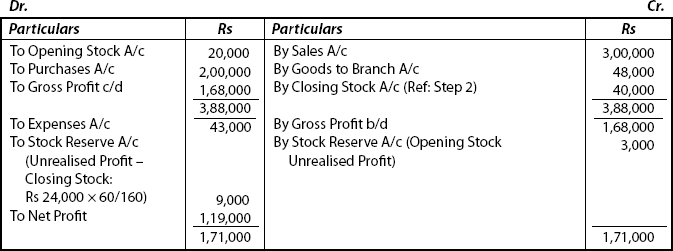
Step 5
Branch Trading and Profit and Loss Account for the Year ending Dec 31, 2008

Illustration: 29
Rose Ltd operates a number of retail shops of which goods are invoiced at wholesale price which is cost plus 25% shops sell the goods at the list price which is cost plus 100% from the following particulars. Prepare the necessary ledger accounts:
|
|
Rs |
|
Opening Stock at Shops |
600 |
|
Goods sent to Shops |
2,40,000 |
|
Goods returned by Shops |
2,400 |
|
Goods sold at Shops |
1,56,000 |
|
Goods returned by Customers at Shops |
6,000 |
|
Goods destroyed by Accident (Retail Value) |
1,920 |
|
Expenses at the Shop |
30,450 |
Solution
Step 1
|
Rs |
|
Price – Profit Ratio |
|
|
Cost Price be |
100 |
(Assumed) |
Add: Wholesale Profit |
25 |
(Wholesale Price is Cost plus 250% Given) |
Wholesale Price |
125 |
|
Add: Retail Profit |
75 |
(Rs 200 – Rs 125) |
List Price |
200 |
(Cost plus 100% Rs 100 + Rs 100 = Rs 200) |
Step 2
Branch Stock Account

Step 3
Branch Profit and Loss A/c

Step 4
Branch Stock Reserve Account

Step 5
Extract of H.O. Profit and Loss Account

OBJECTIVE 6: INDEPENDENT BRANCHES
- Branches maintain a complete record of transaction.
- The H.O. permits a few branches to operate independently relating to purchase, sales and the like transactions but well within the control of H.O.
- These independent branches maintain a complete record of transactions and at the end of accounting period they submit a copy of final accounts (Receipts and Payments A/c and Trial Balance) to the H.O. for incorporation in the books of H.O.
- The net operating results of the branches (profit or loss) are passed onto the H.O. by the independent branches.
- The connection link between the branches and H.O. is maintained by way of keeping
- Branch accounts in the books of the H.O.
- H.O. account in the book of the branches
- For independent branches, the accounting treatment for the following transactions deserves much importance
Accounting Treatment for some transactions under this method
- Accounting for Fixed Assets
- Accounting for Goods-in-transit and Cash-in-transit
- Accounting for Head office expenses to be charged to branch
- Accounting for Inter-branch Transactions
6.1 Accounting for Fixed Assets
The accounts of branch Fixed Assets may be maintained by the branch or the H.O.
In case if the branch maintains its records, entries will be passed in the usual manner.
In case if the H.O. maintains the fixed assets of the branch, the following journal entries have to be passed:
| Transaction | H.O. Books | Branch Books |
|---|---|---|
1. Payment by the H.O. |
Branch Asset A/c Dr. |
No Entry |
|
To Cash A/c |
|
2. Payment by the Branch (cash) |
Branch Asset A/c Dr. |
H.O. A/c Dr. |
|
To Branch A/c |
To Cash A/c |
3. Payment by the Branch (credit) |
Branch Asset A/c Dr. |
H.O. A/c Dr. |
|
To Branch A/c |
To Sundry Creditors A/c |
4. Depreciation |
Branch A/c Dr. |
Depreciation A/c Dr. |
|
To Branch Assets A/c |
To H.O. A/c |
Illustration: 30
On Apr 1, 2008, Mumbai H.O. purchases a refrigerator for Rs 15,000 for its Manipal Branch. On Sept 30, 2008 the B.O. purchases fans for Rs 3,000.
The rate of depreciation on refrigerator is 10%, for fans @ 15% p.a. The account closes on Mar 31, 2009.
Pass the necessary journal entries in the books of Mumbai H.O. and Manipal branch when
- Accounts of Fixed Assets are maintained at H.O.
- Accounts of Fixed Assets are maintained at the branch
Solution
Journal of H.O.
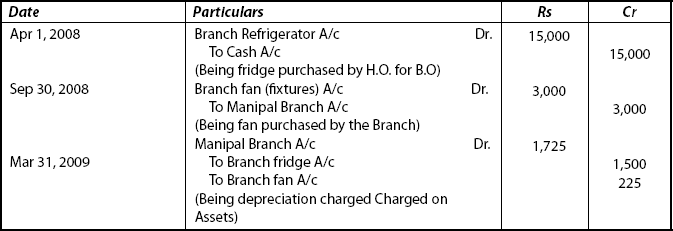
Journal of Manipal

Fixed Assets Account maintained at Branch Journal of H.O.

Journal of Manipal

6.2 Accounting for Goods In Transit
Sometimes, the balance of Branch Account (in the H.O. books) and that of the H.O. Account (in the branch books) do not tally. This is due to the factor “Goods in Transit,” i.e. the goods delivered by the H.O. (or returned by the branch) would not have reached its destination in time.
In order to reconcile the two accounts, the following entry is passed in the books of the H.O.
Accounting Entry for Goods in Transit
|
Goods in Transit |
|
A/c |
Dr. |
|
To Branch |
|
A/c |
|
|
|
and |
|
|
|
In the books of the branch as: |
|||
|
Goods in Transit |
|
A/c |
Dr. |
|
To H.O. |
|
A/c |
|
In the next accounting year, after the goods actually reached its destination entry will be:
- When H.O. supplied goods to branch:
Branch A/c Dr.
To Goods in Transit A/c
To Goods-in-Transit A/c
- When the branch returned the goods to H.O.:
Goods sent to Branch A/c Dr.
To Goods in Transit A/c
The same situation may arise when remittances are made, which is called cash in transit.
Adjustment Entry in the Books of H.O.
|
Adjustments Entry for Cash in Transit |
||
|
Cash in Transit |
A/c |
Dr. |
|
To Branch |
A/c |
|
In the next accounting year, the following adjustments entry is passed:
- If H.O. had remitted:
Branch A/c Dr.
To Cash in Transit A/c
- If branch had remitted:
Cash A/c Dr.
To Cash in Transit A/c
In the combine or consolidated Balance Sheet, both Goods in Transit and Cash in Transit will be shown as an Asset.
Illustration: 31
On Mar 31, 2009, the Trial Balance of Bangalore branch showed a debit balance of Rs 12,900 in H.O. account. On the same day, the Branch Account in the H.O. books stood at Rs 1,600 debit balance. On Mar 27, the H.O. supplied goods amounting Rs 4,500 to the branch where they were received on Apr 3. A remittance of Rs 9,000 sent by the branch on Mar 28 was received by H.O. on Apr 2. Reconcile the branch account.
Solution
Both accounts:
- Branch A/c (in H.O. books)
- H.O. A/c (in Branch books) are shown as “Debit Balances”
So, total difference (total amount of items in transit) is calculated:
|
|
|
Rs |
|
Balance of Branch |
A/c (Debit) |
1,600 |
|
Add: Balance of H.O. |
A/c (Debit) |
12,900 |
|
|
|
13,500 |
Journal Entry for reconciliation in the books of H.O.:

Illustration: 32
From the following particulars, reconcile the H.O. A/c with Branch A/c
|
Rs |
|
Goods sent to Branch |
12,00,000 |
(H.O. Cr.) |
Goods received by Branch |
11,70,000 |
(Branch Dr.) |
Branch A/c |
3,00,000 |
(Dr. in H.O.) |
H.O. A/c |
2,00,000 |
(Cr. in B.O.) |
Solution
Particulars are shown as Cr. balance or Dr. balance
H.O. has credit balance
Branch has debit balance
- Find the Net Difference = Rs 3,00,000 – Rs 2,00,000 = Rs 1,00,000
- Value of Goods in Transit = Rs 12,00,000 – Rs 11,70,000 = Rs 30,000
- Value of Cash in Transit = Rs 1,00,000 – Rs 30,00,000 = Rs 70,000
Journal Entry in the Books of H.O. to reconcile both the accounts

Illustration: 33
From the following particulars reconcile H.O. A/c with the Branch Account
|
|
Rs |
|
Goods sent to Branch |
2,90,000 |
|
Goods received by Branch |
2,70,000 |
|
Net Branch A/c |
1,65,000 |
|
H.O. A/c |
56,000 |
Cash remitted by the branch during the year was Rs 3,25,000 but was shown in H.O. A/c as Rs 2,37,600.
Solution
Both goods in transit and cash in transit value are given.
Besides these, if still there is any difference found, it may be due to some other errors and it is shown as Suspense Account.
Step 1
- Net Difference = Rs 1,65,000 – Rs 56,000 = Rs 1,09,000
- Goods in Transit = Rs 2,90,000 – Rs 2,70,000 = Rs 20,000
- Cash in Transit = Rs 3,25,000 – Rs 2,37,600 = Rs 87,400
- Difference due to Other Errors = Rs 1,09,000 – Rs 20,000 – Rs 87,400 = Rs 1,600
Step 2 Journal Entry to reconcile in the books of H.O.

Accounting of H.O. expenses to be charged to branch when the H.O. to raise a charge is against any branch for the services rendered by H.O., the Journal entry to be passed
Accounting Entry for H.O. Expenses to be Charged Against Branch
- In the books of H.O.:
Branch A/c Dr.
To P & L A/c or (Cash/Bank A/c) or (Respective Expenses)
- In the books of the Branch:
H.O. Expenses A/c Dr.
Or (Appropriate Expense A/c)
To H.O. A/c
Illustration: 34
Journalise the following transactions in the books of H.O and Chennai B.O.
- H.O. charges Rs 5,000 from Chennai Branch as miscellaneous office expenses.
- An analysis of H.O. and technical services shows that the share of branches there is 50% of the share of H.O.
- Among the branches, the share of Chennai Branch is twice the share of Mangalore Branch. Total expenses paid Rs 1,00,000, Rs 30,000 being paid in advance and Rs 20,000 being still outstanding.
Solution
Journal of H.O.
| Particulars | Dr. (Rs) | Cr. (Rs) |
|---|---|---|
(i) Chennai Branch A/c Dr. |
5,000 |
|
To Miscellaneous Expenses A/c |
|
5,000 |
(Being Miscellaneous Expenses charged to Chennai Branch.) |
|
|
(ii) Chennai Branch A/c Dr. |
20,000 |
|
[(Rs 1,00,000 − Rs 30,000 + Rs 20,000) × 1/3 × 2/3] |
|
|
(Advance) (o/s) |
|
|
Mangalore Branch A/c Dr. |
10,000 |
|
[(Rs 1,00,000 − Rs 30,000 + Rs 20,000) × 1/3 × 1/3] |
|
|
To H.O. (Misc. + Tech. Services) Expenses A/c |
|
30,000 |
(Being share of expenses) |
|
|
Journal of Chennai Branch
| Particulars | Dr. (Rs) | Cr. (Rs) |
|---|---|---|
(i) Miscellaneous Expenses A/c Dr. |
5,000 |
|
To H.O. A/c |
|
5,000 |
(Being Miscellaneous Expenses Charged to H.O.) |
|
|
(ii) H.O. Expenses (Technical) A/c Dr. |
25,000 |
|
To H.O. A/c |
|
25,000 |
(Being the H.O. Misc. and Tech. Services Expenses Charged to H.O.) |
|
|
6.3 Accounting for Inter-branch Transactions
- Transactions among branches are called “inter-branch transactions.”
- These transactions may occur with or without instructions from H.O.
- Inter-branch transactions may be recorded in two methods:
- It is recorded directly by maintaining current account of a branch in another branch’s book.
- It is recorded indirectly by all branches by making entries though H.O. Account.
Illustration: 35
Journalise the following transactions in the books of the H.O. as well as B.O.
- Goods worth Rs 12,000 are supplied by Mumbai Branch to Surat Branch.
- Mumbai Branch draws a Bills Receivable for Rs 12,000 on Surat Branch which sends its acceptance.
- H.O. charges Rs 5,500 from Mumbai Branch as H.O. Administrative expenses.
[B.Com (Hons) – Delhi – Modified]
Solution
(i) Mumbai Branch Books
| Particulars | Dr. (Rs) | Cr. (Rs) |
|---|---|---|
(i) H.O. A/c |
12,000 |
|
To Goods sent to Branch A/c Dr. |
|
12,000 |
(Being goods sent to Surat Branch.) |
|
|
(ii) Bills Receivables A/c Dr. |
12,000 |
|
To H.O. A/c |
|
|
(B/R drawn accepted) |
|
12,000 |
(iii) H.O. Administrative Expenses A/c Dr. |
5,500 |
|
To H.O. Account |
|
5,500 |
(Being H.O. Expenses charged to Branch.) |
|
|
(ii) Surat Branch Books
| Particulars | Dr. (Rs) | Cr. (Rs) |
|---|---|---|
(i) Goods sent to Branch A/c Dr. |
12,000 |
|
To H.O. Account Dr. |
|
12,000 |
(Being goods received.) |
|
|
(ii) H.O. Account Dr. |
12,000 |
|
To Bills Payable Account |
|
|
(Being the amount for goods by way of bills.) |
|
12,000 |
(iii) H.O. Books
| Particulars | Dr. (Rs) | Cr. (Rs) |
|---|---|---|
(i) Surat Branch A/c Dr. |
12,000 |
|
To Mumbai Branch A/c |
|
|
(Being goods sent to Surat Branch from Mumbai Branch.) |
|
12,000 |
(ii) Mumbai Branch A/c Dr. |
12,000 |
|
To Bills Payable A/c |
|
|
and |
|
12,000 |
Bills Receivable A/c Dr. |
12,000 |
|
To Surat Branch A/c |
|
12,000 |
(Being the amount for goods transactions among branch.) |
|
|
(iii) Mumbai Branch A/c Dr. |
5,500 |
|
To Profit and Loss A/c |
|
5,500 |
(Being H.O. expenses charged to Mumbai Branch.) |
|
|
Illustration: 36
A D.T.H. Company having its H.O. in Mumbai with branches at Nagpur and Pune closes its annual accounts on Mar 31. When the following transactions took place:
- Remittances of Rs 50,000 made by Nagpur Branch to its H.O. on Mar 29 received by the H.O. on Apr 3.
- Dish antennas valuing Rs 40,000 despatched by Pune Branch on Mar 28 (under instructions from H.O.) received by the Nagpur Branch on Mar 30.
- Depreciation amounting to Rs 720 on Nagpur Branch fixed assets when accounts of fixed assets are maintained at the H.O.
- Dish worth Rs 60,000 despatched by H.O. on Mar 29, received by Pune Branch on Apr 3.
Show the adjustment entries in the books of the H.O. and the Nagpur Branch as at the close of the year (Ignore Narrations).
Solution
Mumbai (H.O.) Journal
| Particulars | Dr. (Rs) | Cr. (Rs) |
|---|---|---|
(1) No Entry |
|
|
(2) Nagpur Branch A/c Dr. |
40,000 |
|
To Pune Branch A/c |
|
40,000 |
(3) Nagpur Branch A/c Dr. |
720 |
|
To Nagpur Branch Assets A/c |
|
720 |
(4) Goods-in-Transit A/c Dr. |
60,000 |
|
To Pune Branch A/c |
|
60,000 |
Nagpur Branch Journal
| Particulars | Dr. (Rs) | Cr. (Rs) |
|---|---|---|
(1) Cash-in-Transit A/c Dr. |
50,000 |
|
To H.O. A/c |
|
50,000 |
(2) Goods from Branches A/c Dr. |
40,000 |
|
To H.O. A/c |
|
40,000 |
(3) Depreciation A/c Dr. |
720 |
|
To H.O. A/c |
|
720 |
Illustration: 37
Healthy Pharmaceuticals Ltd., Shimla has branches at Delhi, Mumbai, Chennai and Kolkata. These branches are allowed transactions INTERSE under advice to H.O. Following are the inter-branch transactions for the month of June 2008.
I Delhi Branch
- Sent goods to Mumbai Rs 5,000; Chennai Rs 8,000 and Kolkata Rs 13,000
- Drawn bills on Mumbai Rs 3,000; Chennai Rs 5,000 and Kolkata Rs 9,000
- Received goods from Mumbai Rs 15,000; Chennai Rs 9,000 and Kolkata Rs 20,000
- Bills accepted from Mumbai Rs 3,000; Chennai Rs 5,000 and Kolkata Rs 8,000
II Mumbai Branch: (in addition to transactions as aforesaid)
- Sent goods to Chennai Rs 32,000; Kolkata Rs 30,000
- Drawn bills on Chennai Rs 17,000; Kolkata Rs 7,000
- Received goods from Chennai Rs 12,000; Kolkata Rs 10,000
- Accepted bills drawn by Chennai Rs 3,500; Kolkata Rs 6,000
III Chennai Branch: (in addition to transactions as aforesaid)
- Goods sent to Kolkata Rs 5,000
- Bills drawn on Kolkata Rs 3,000
- Goods received from Kolkata Rs 7,500
- Bills accepted, drawn by Kolkata Rs 9,000
Show out the Journal entry that the H.O. would pass on June 30, 2008, showing the working out of the net figures in a tabular form.
Solution
H.O. Journal (Shimla)

Solution
Statement of Inter-Branch Transactions

OBJECTIVE 7: INCORPORATION OF BRANCH TRIAL BALANCE
The H.O. and its various branches function as a single entity. As such the net result of operations of the branch is usually incorporated in the books of the H.O. Only after incorporation, a Consolidated Balance Sheet can be prepared, which reflects the true financial position of the business entity in its entirety.
Any of the following methods may be adopted for this:
- Detailed Consolidated Method
- Abridged Consolidated Method
- Separate Final Accounts Method
7.1 Detailed Consolidated Method
This method is widely and commonly used with the following procedure:
- All revenue items, assets and liabilities of the branch are transferred to H.O. Account (in the books of the branch).
- Such transferred items are incorporated (in the books of H.O.).
- Consolidated Trading and Profit and Loss Account and Consolidated Balance Sheet are prepared (in the books of H.O.).
The Journal entries to be passed under this scheme are:
| Items | Account to be | |
|---|---|---|
| Debited | Credited | |
1. Shown on debit side of Trading A/c (after adjustments) |
Branch Trading |
Branch |
2. Shown on credit side of Trading A/c (after adjustments) |
Branch |
Branch Trading |
3. (a) Gross Profit (transfer) |
Branch Trading |
Branch P & L |
(b) Gross Loss (transfer) |
(Reverse entry) |
|
4. Expenses & Losses shown on debit side of P & L A/c (after adjustments) |
Branch P & L |
Branch |
5. Shown on credit side of Branch P & L A/c (after adjustments) |
|
|
6. (a) NET PROFIT (transfer) |
Branch P & L |
General P & L |
(b) NET LOSS (transfer) |
(Reverse the above entry) |
|
7. Branch Assets |
Branch Assets |
Branch |
8. Branch Liabilities |
Branch |
Branch |
Notes:
- After adjustments mean, items relating to outstanding and prepaid are to be adjusted.
- In case, if more than one accounting year occurs, in the beginning of next accounting year, entry 7 and entry 8 have to be reversed.
- After recording all entries, the H.O. Account in the books of the branch and B.O. A/c in the books of H.O. will be closed.
7.2 Abridged Consolidated Method
Under this method not all the items are transferred, as the name itself suggests that this is an abridged form of the Detailed Consolidated Method, discussed above.
Under this, only transactions relating to following items are transferred for incorporation:
- Branch Net Profit/Loss
and
- Branch Assets and Liabilities
7.3 Separate Final Accounts Method
Under this method, separate Trading and Profit and Loss Account and separate Balance Sheet for Branch are prepared from this and only net profit/loss is transferred to H.O. Then, again a separate Trading and Profit and Loss Account and Balance Sheet is prepared in the books of H.O.
To put in other way, separate Trading and Profit and Loss Account and Balance Sheet of Branch and H.O. are prepared in their respective books.
Illustration: 38
The following is the Trial Balance of the Goa Branch as of Sep 30, 2008.
Trial Balance of Goa Branch as at 30, Sep 30, 2008
| Rs | Rs | |
|---|---|---|
H.O. Head Office account |
16,200 |
|
Stock on October 1, 2007 |
30,000 |
|
Purchases |
89,000 |
|
Goods received from H.O. |
45,000 |
|
Sales |
|
1,90,000 |
Goods supplied to H.O. |
|
30,000 |
Salaries |
7,500 |
|
Debtors |
18,500 |
|
Creditors |
|
9,250 |
Rent |
4,800 |
|
Office expenses |
2,350 |
|
Cash in hand Hand and at Bank |
8,900 |
|
Furniture |
7,000 |
_____ |
|
2,29,250 |
2,29,250 |
- Stock on hand was valued at Rs 13,500.
- The Branch Account in the H.O. Books on Sep 30, 2008 stood at Rs 2,300 (Dr.).
- On Sep 27, 2008, the H.O. forwarded goods to the values of Rs 12,500 to the branch, where they were received on Oct 5, 2008.
- A cash remittance of Rs 6,000 on Sep 28 was received by H.O. on Oct 3, 2008.
Required
- Journal entries required to incorporate the above figures.
- The results of trading at the branch separately in the books of H.O.
- Goa Branch Account in the books of H.O.
Solution
Journal Entries
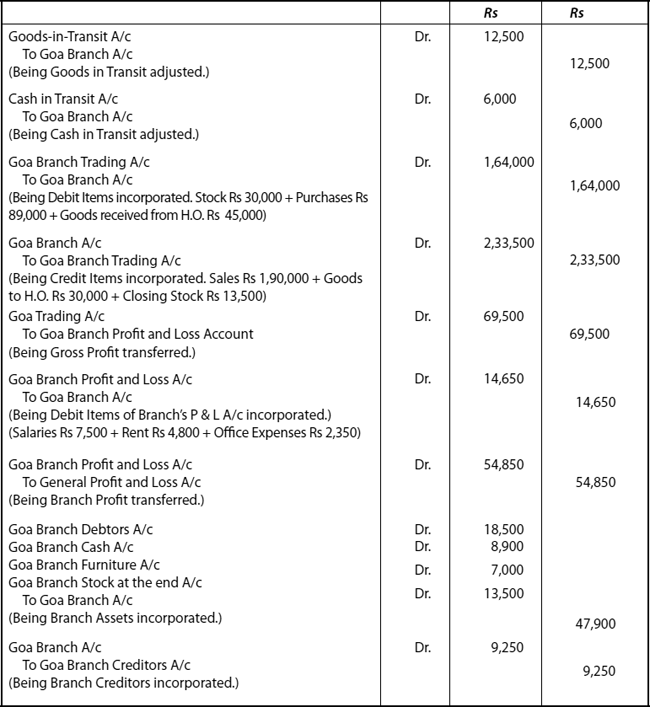
Goa Branch Account

Goa Branch Trading and Profit and Loss Account for the year ending 30 September 30, 2008

Illustration: 39
Vasudev, a Chennai trader opens a new branch in Trichy which trades independently of the H.O. The transactions of the branch for the year ended Mar 31, 2009 are as follows:
|
|
|
Rs |
|
Goods Supplied by H.O. |
|
40,000 |
|
Purchases from Outsides: |
|
|
|
Credit: |
31,000 |
|
|
Cash: |
6,000 |
|
|
|
|
37,000 |
|
Sales Credit: |
50,000 |
|
|
Cash: |
9,200 |
|
|
|
|
59,200 |
|
Cash received from Customers |
|
60,800 |
|
Cash paid to Creditors |
|
28,400 |
|
Expenses paid by the Branch |
|
17,900 |
|
Furniture and Fixtures purchased by Branch on Credit |
|
7,000 |
|
Cash received from H.O. initially |
|
8,000 |
|
Remittances to H.O. |
|
22,000 |
Additional Information
- The accounts of the branch fixed assets are maintained at H.O. Books
- Write off depreciation on furniture @ 5% p.a.
- The branch remitted on Mar 29, 2009 Rs 4,000 was received by the H.O. on Apr 2, 2009
- The branch closing stock is valued at Rs 24,000.
You are required to prepare the Trichy Branch Trading and Profit and Loss Account and the Trichy Branch Account in the H.O. Books and H.O. Account in the books of the Branch after incorporation of the branch Trial Balance.
Solution
Note:
- Rs 4,000 is to be treated as cash in transit.
- In the Branch Account, value of furniture and fixtures is shown on the credit side and value of depreciation is shown on the debit side.
Trichy Branch Account
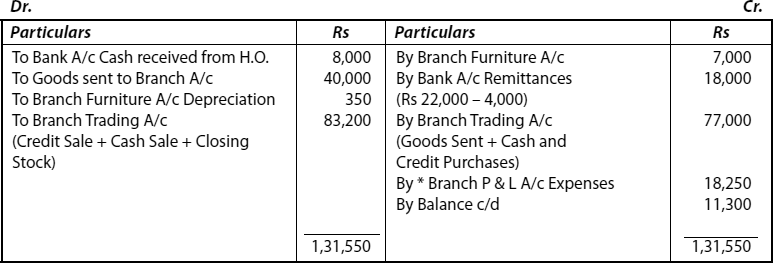
Branch Trading and Profit and Loss Account for the Year Ending on Mar 31, 2009

In the Books of the Branch Chennai Head Office Account

Illustration: 40
A trader of Chennai had a branch in Kolkata. The branch gets goods partly from Chennai H.O. and partly from outsiders. The branch keeps a separate set of books. The following balances were extracted.
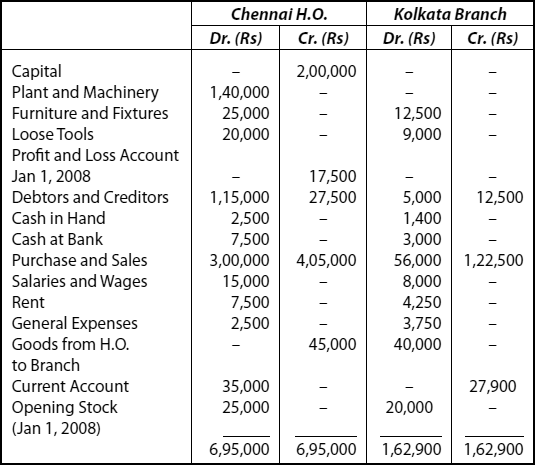
The difference between the balances of H.O. Current Account and Branch Account is due to goods and cheques in transit as at the date of preparation of Trial Balance. Tent of B.O. remains unpaid Rs 75. Plant, furniture and loose tools are to be depreciated at 10% p.a., 15% p.a. and 20% p.a., respectively. Stocks in trade valued on Dec 31, 2008 were as follows:
Prepare a Combined Trading and Profit and Loss Account for the year ending on Dec 31, 2008 and a Balance Sheet on that date.
(B.Com Kolkata – Adapted)
Solution
Combined Trading and Profit and Loss Account for the Year Ending Dec 31, 2008
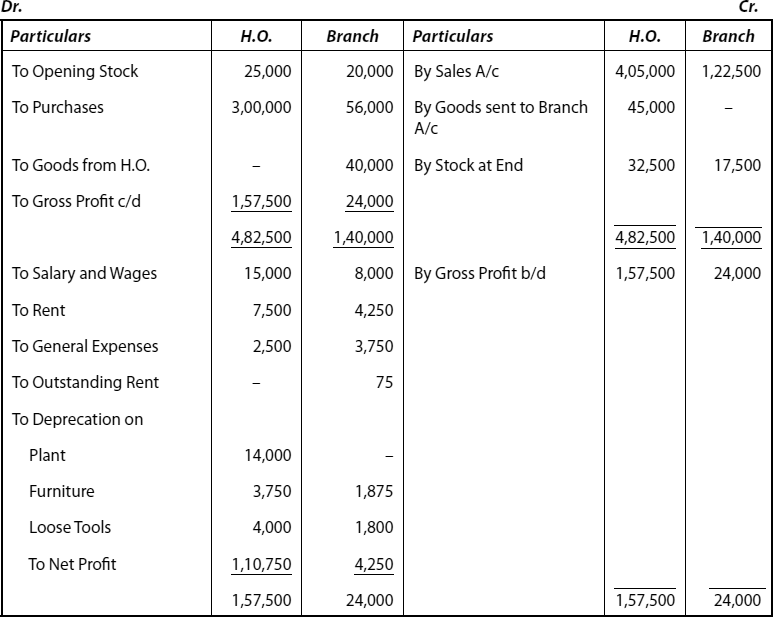
Balance Sheet as on Dec 31, 2008
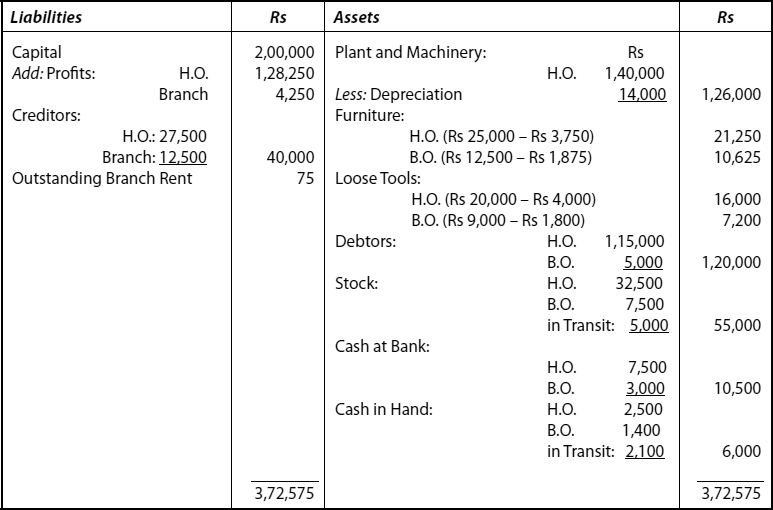
Illustration: 41
Raj Ltd having H.O. in Chennai has a Branch at Kolkata where a complete set of books is maintained. All purchases are made at Chennai and stock required by the branch is invoiced to it by H.O. at selling price less 15%. The branch manager is entitled to a commission equal to one-third of net profit earned by the branch on the basis of invoice price. The following are the respective trial balance of the H.O. and the branch as on Mar 31, 2009.

The cost of price invoiced to Kolkata was Rs 40,950. The stock in hand at the end of the year at Chennai was valued at Rs 22,635 at cost and at Kolkata Rs 7,080 at cost and Rs 8,830 at invoice price. The difference between the adjustment accounts is due to remittance in transit from the branch to H.O. You are required to prepare the Trading and Profit and Lost Account for the year enduring on Mar 31, 2009 in Columnar Form and the Consolidated Balance Sheet at that date.
Solution
Trading and Profit and Loss Account for the Year Ending on Mar 31, 2009

Balance Sheet as on Mar 31, 2009
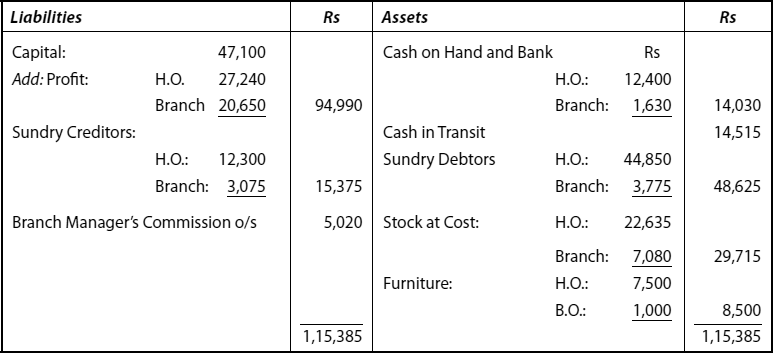
Memorandum Kolkata Branch Trading and P & L A/c (Invoice Value)

Illustration: 42
The H.O. of a business and its branch keep their own books and each prepares its own Profit and Loss Account. The following are the balances appearing in the two sets of books as on Mar 31, 2009 after ascertainment of profit and after making all adjustments except those referred to below:
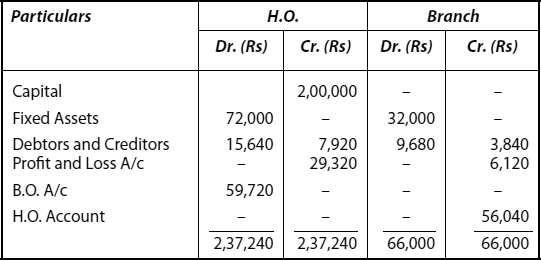
Set out the Balance Sheet of the business as on Mar 31, 2009 and the Journal entries necessary (in both sets of books) to record the adjustments dealing with the following:
- On Mar 30, 2009, the branch had sent a cheque for Rs 2,000 to the H.O., neither received by H.O. nor credited to branch A/c till Apr 5, 2009.
- Goods valued at Rs 1,680 had been forwarded by the H.O. to the branch and invoiced on Mar 28, 2009, but were neither received by the branch nor dealt with in branch’s books till Apr 9, 2009.
- The profit shown by the branch to be transferred to the H.O. books.
- Branch assets and liabilities are to be recorded in the H.O. books.
[B.Com (Hons) Delhi – Modified]
Solution
H.O. Journal
| Particulars | Dr. (Rs) | Cr. (Rs) |
|---|---|---|
Branch Fixed Assets A/c Dr. |
32,000 |
|
Branch Stock A/c Dr. |
21,480 |
|
Branch Debtors A/c Dr. |
9,680 |
|
Branch Cash A/c Dr. |
2,820 |
|
Cash in Transit A/c Dr. |
2,000 |
|
Goods in Transit A/c Dr. |
1,680 |
|
To Branch A/c |
|
69,680 |
(Being Branch Assets recorded in H.O. Books) |
|
|
Branch A/c Dr. |
3,840 |
|
To Branch Creditors A/c |
|
3,840 |
(Being Branch Creditors recorded in H.O. Books) |
|
|
Branch A/c Dr. |
6,120 |
|
To Profit and Loss Account |
|
6,120 |
(Being Branch P & L A/c balance transferred to H. O. P & L A/c) |
|
|
Balance Sheet as on Mar 31, 2009
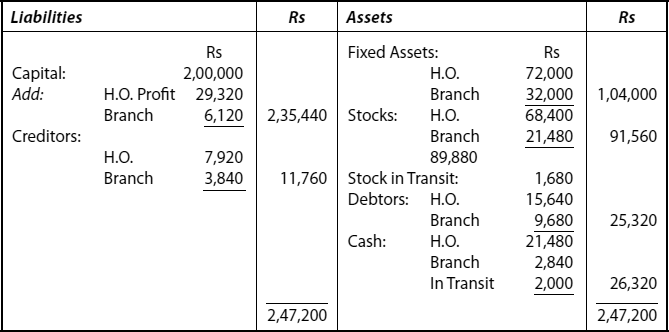
Summary
- A branch is any establishment carrying on either the same or substantially the same activity as that carried on by the H.O. of the establishment.
- Objectives are (i) to increase the volume of sales, (ii) to enhance profit margin and (iii) to eliminate middlemen.
- Branches are classified as (i) inland and (ii) foreign branches. Further inland branches are classified into (1) dependent and (2) independent branch.
- Accounting records to be maintained by dependent branches: (i) Stock Register, (ii) Cash Book, (iii) Petty Cash Book, (iv) Customer’s Ledger and (v) Branch Returns.
- For dependent branches, the system of accounting is maintained by H.O. method of recording transactions in the books of H.O. and preparation of Profit/ Loss Account, (Branch Account) Memorandum Branch Debtors Account, ascertainment of missing figures to prepare Branch Account, calculation of profit margin (Load) under Debtors System are explained through Illustrations (No. 1–14).
- Stock Debtors System – comprises a number of accounts to compute various items. The following table reveals clearly this aspect
Sl. No. Name of the Account Purpose for Which It is to be Kept 1.Branch Stock Account
To ascertain any shortage or surplus in stock
2.Branch Debtors Account
To ascertain closing Debtors
3.Branch Expenses Account
To compute Total Expenses at a Branch
4.Branch Adjustment Account
To compute Gross Profit/Loss
5.Branch Profit and Loss A/c
To compute Net Profit/Loss
6.Goods Sent to Branch Account
To find the Net Cost of Goods sent to the Branch
7.Branch Cash A/c
To show all Cash Transactions
8.Branch Fixed Assets A/c
To Record Transactions of Fixed Assets
- Procedure to prepare all these accounts is explained in illustrations 15–21.
- Final Account System: It is another method to ascertain profit/loss of a branch. Trading and Profit and Loss Account is to be prepared in the place of branch account under this method. The method is explained in the illustrations 22–24.
- Wholesale Branch Method: Under this system, the H.O. supplies goods to the wholesalers and sells their through retail branches also. The retail branches sell the goods at a higher price than the wholesale price. The difference in price is called “Additional Profit.” Profit calculations are illustrated (in 25–28) under this method.
- Independent Branches: Branches maintain a complete record of transactions. Accounting (Treatment) for (i) Fixed Assets, (ii) Goods in Transit and Cash in Transit, (iii) H.O. expenses to be charged to branch and (iv) Inter-Branch transactions all explained in illustrations 29–36.
- Incorporation of Branch Trial Balance: The net result of operations of the branch is incorporated in the books of H.O. After incorporation a Consolidated Balance Sheet is prepared by (i) Detailed Consolidated Method, (ii) Abridged Consolidated Method and (iii) Separate Final Accounts Method are employed for this purpose. These are explained in illustrations 37–41.
Key Terms
Branch: A branch is any establishment carrying on either the same or substantially the same activity as that carried on by the H.O. of the establishment.
Branch Accounting: Branch accounting relates to recording of trading transactions in respect of their dealings with H.O., with outsiders and other branches.
Dependent Branches: Branches that do not perform accounting functions and which sell the goods supplied by the H.O. on cash basis are called dependent branches. In general, they depend on the H.O. for any type of activity.
Debtors Method: It is one type of accounting system for dependent branches. The H.O. maintains separate Branch Account for each branch.
Independent Branch: Unlike dependent branches, independent branches perform accounting functions by maintaining complete record of transactions.
Final Account Method (System): This is another type of accounting system for branches, where profit or loss of the branch is ascertained by preparing Trading and Profit and Loss Account in the place of branch account.
Stock-Debtors System: This is another type of accounting system where an elaborate accounting procedure is followed that comprises a number of accounts for each branch.
Wholesale Branch Method: This is one type of accounting system where “additional profit” and “load” factors play a key role in preparing Branch Trading and Profit and Loss Account.
Reference
Sehgal, Ashok and Deepak Sehgal, “Advanced Accounting,” Part I Taxmann Applied Services, New Delhi.
Shukla M.C., T.S. Grewal and S.C. Gupta, “Advanced Accounts,” Vol. I, Chand & Co, New Delhi, 2008.
Monga J.R., “Financial Accounting: Concepts and Application,” Mayur Paper Back, New Delhi, 2007–08.
Tulisan P.C., “Financial Accounting,” Pearson Education, New Delhi, 2004.
A Objective-type Questions
I State whether the following statements are True or False
- Branch accounting is concerned with recording of transactions of different branches in respect of their association with the H.O., with other branches as well with outsiders.
- Dependent branches are mere selling agencies and are controlled by the H.O.
- Goods supplied to branches for sale are always invoiced at market price only.
- Dependent branches perform accounting functions for themselves.
- A branch account is a combination of real accounts and nominal accounts.
- Petty expenses paid by the branch manager out of cash in hand in the branch are not shown in the branch account.
- Usually, dependent branches do not sell goods on credit.
- Entities have to be made in the branch account in respect of sales returns and discount allowed.
- When goods are transferred between H.O. and branches at a price above cost, it is termed as “loaded price.”
- Credit purchases would appear in the branch account.
- Credit sales would not affect the branch account directly.
- Under Debtors System, control over the stock can be exercised effectively.
- Under Stock-Debtors System, all items are entered in the branch stock account at loaded price only.
- When the stock appears at the loaded price, it is essential to open Stock Reserve Account.
- Normal loss affects both gross profit and net profit.
- Abnormal loss affects only gross profit.
- Independent branches also operate within the framework of broad policies laid down by the H.O.
- Goods in transit appear as an asset in the balance sheet.
- Cash in transit is a liability.
- Goods returned by customers direct to branch are recorded in branch account.
Answers
1. True |
2. True |
3. False |
4. False |
5. True |
6. True |
7. True |
8. False |
9. True |
10. False |
11. True |
12. False |
13. True |
14. True |
15. False |
16. False |
17. True |
18. True |
19. False |
20. False |
II Fill in the blanks with suitable words
- _______ branches are situated in the same country, where H.O. is situated.
- _______ branches cannot procure goods from local sources.
- To meet incidental expenses, branch managers are supplied with petty cash on _________ system.
- Dependent branches keep only _______ records.
- _______ branches do not perform accounting functions for themselves.
- Generally, a branch account is a combination of real and ________ accounts.
- Sales returns, bad debts, discounts allowed do not appear in the _________ under Debtors system.
- To ascertain missing figure in respect of debtors, _________ A/c is prepared.
- A profit margin of 20% on sale price is equal to ________% profit on cost.
- Under Debtors system, H.O. can calculate only ________ profit.
- ________ and ________ purchases would not appear in the branch account.
- The important limitation of Debtors system is the absence of control over ________.
- Normal and abnormal losses are not adjusted with stock in the _______ Account under Debtors system.
- Branch Stock Account is a ______ account in nature, under Stock Debtors System.
- Branch Stock Account is always prepared at __________ price under Stock-Debtors System.
- Invoice Price = Cost + ________.
- Branch profit/loss is transferred to __________ Account.
- Normal loss is a ________ charge, affects only the gross profit.
- The stock reserve will be equal to the difference between the wholesale price and _________.
- Goods in transit and cash in transit are to be treated as _________ and hence they are shown in the balance sheet.
Answers
- Inland
- Dependent
- Imprest
- Memorandum
- Dependent
- Nominal
- Branch Account
- Memorandum Branch Debtors
- 25%
- Net
- Cash; Credit
- Stock
- Branch
- Real
- Invoice
- Profit margin
- General Profit and Loss
- Direct
- Cost Price
- Assets
B Short Answer-type Questions
- What is meant by branch accounting?
- Explain dependent branch.
- What is meant by an independent branch?
- Name the method under which gross profit of a dependent branch can be computed?
- Name the method under which both gross profit and net profit of a branch can be ascertained?
- How will you deal with normal loss of stock under Debtors Method?
- How will you deal with abnormal loss of stock under both the methods?
- How will you deal with the following under Debtors Method?
- Goods returned by branch customers directly to H.O.
- Cash remitted by branch customers directly to H.O.?
- What is “Load”?
- Explain the terms goods in transit and cash in transit. How would you treat them?
- How would you deal with surplus in Branch Stock Account under Stock-Debtors System?
- Explain “Stock Reserve Account.”
- How will you deal with “Invoice Price” under Debtors method and Stock-Debtors method?
- How will you deal with insurance claim under both the methods?
- Write short note on Final Account Method.
- What do you mean by a branch operating on wholesale basis?
C Essay-type Questions
- Explain the essential features of maintaining branch account under Debtors System of branch accounting.
- Explain the essential features of maintaining branch account under Stock and Debtors system of branch account.
- Explain the procedure of incorporating the branch trial balance in H.O. books.
D Exercises
Model: Debtors Method
1. Raj & Co had a branch at Delhi. Goods are invoiced to the branch at cost plus 25%. Branch is instructed to deposit cash everyday in the H.O. account with the bank. All expenses are paid by cheques by the H.O. except petty cash expenses which are paid by the branch manager. From the following information prepare branch account in the books of H.O.:
| Rs | |
|---|---|
Stock on Jan 1, 2009 |
7,500 |
Stock on Dec 31, 2009 |
9,000 |
Sundry Debtors on Jan 1, 2009 |
4,200 |
Sundry Debtors on Dec 31, 2009 |
5,400 |
Cash Sales for the year 2009 |
32,400 |
Credit Sales for the year 2009 |
21,000 |
Cash remitted to the H.O. |
45,000 |
Furniture purchased by the Branch Manager |
3,600 |
Goods invoiced from the H.O. |
54,600 |
Expenses paid by the H.O. |
4,920 |
Expenses paid by the Branch |
360 |
[C.S. (foundation) – Modified]
[Answer: Branch Profit – Rs 5,640]
2. Gain & Co. had a branch at Tiruchirapalli. You are required to prepare branch account in the books of Gani & Co. to ascertain profit made at Tiruchirapalli branch. Transactions during the year ending Mar 31, 2009 were as follows:

It was required to write off furniture @ 10% p.a. No depreciation is provided on additions during the year.
Answers: Profit 24,000
3. Renu Ltd. Trichy has a branch at Madurai. Goods are invoiced to the branch at selling price being cost plus 25%. The branch keeps its own sales ledger and deposits all cash received daily to the credit of the H.O. account at Madurai. All expenses are paid by cheque from Trichy.
From the following information, prepare the branch account in the H.O. books. Carry out necessary adjustments to ascertain the profit made by the branch during the year:

Answer: Net Profit – Rs 29,000
4. A trader has a branch at Surat to which goods are invoiced at cost plus 20%. Prepare a branch account in H.O. books from the following particulars:

Answer: Branch Profit – Rs 90,500
5. Mr. V.R. with H.O. at Delhi who carried on a retail trade opened a branch at Nagpur on Oct 1, 2009 where all sales were on credit basis. All cash collected was immediately remitted to H.O. All goods required by the branch were supplied from H.O. and were invoiced to the branch at 10% above cost. The following were the transactions:

The stock of the goods held by the branch on Dec 31, 2009 amounted to Rs 26,700 at invoice price to branch. Record these transactions in the H.O. books. Show the branch gross profit for the three months ended on Dec 31, 2009.
Answer: Gross Profit – Rs 18,681.50
6. Prepare a branch account, from the following data:
| Rs | |
|---|---|
Opening Stock at the Branch |
75,000 |
Goods sent to Branch |
2,25,000 |
Expenses: |
|
Salaries |
25,000 |
Rent |
8,000 |
Other Expenses |
1,880 |
Sales (cash) |
3,00,000 |
Closing stock could not be ascertained but it is known that the branch usually sells goods at cost plus 20%. The branch manager is entitled to commission of 5% of profit of branch after charging such commission.
Answer: Profit Rs 14,400; Commission: Rs 720
Model: Stock and Debtors System
7. Shimla H.O. supplies goods to its branch at Chennai at invoice price which is cost plus 50%. All cash received by the branch is remitted to Shimla and all branch expenses are paid by H.O. From the following particulars related to Chennai branch for the year 2009, prepare (i) Branch Account, (ii) Branch Stock Account, (iii) Branch Debtors Account, (iv) Branch Adjustment Account and (v) Branch Expenses Account to ascertain Gross Profit and Net Profit made by the Branch:
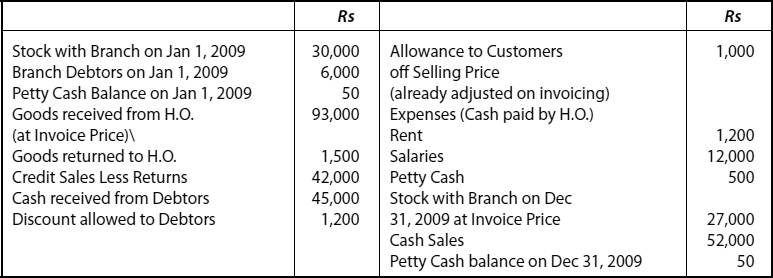
Note: Allowance to customers may be treated as sales promotional expense.
[B.Com – Modified]
Answer: Gross Profit Rs 31,000; Net Profit – Rs 16,100
8. Mr. Rai has a branch at Hyderabad and Vijayawada and the goods are invoiced at a profit of 20% on sales. Following information is available of the transactions at Hyderabad branch for the year ending Dec 31, 2009:
| Transaction | As on Jan 1, 2009 Rs | As on Dec 31, 2009 Rs |
|---|---|---|
Stock at Invoice Price |
1,20,000 |
? |
Debtors |
36,000 |
33,000 |
Petty Cash |
450 |
750 |
Transactions during the year 2009:
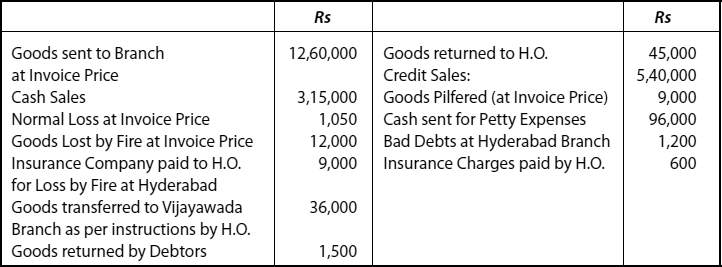
Note: Goods transferred to Vijayawada Branch were in transit (as given above) on Dec 31, 2009.
You are required to prepare the necessary ledger accounts for Hyderabad Branch under Stock and Debtors System in the books of H.O.
(B.Com – Modified)
Answer: Branch Stock (Hyderabad) |
Rs 4,23,450 |
Gross Profit |
Rs 1,69,860 |
Net Profit |
Rs 64,560 |
9. Mr. X of Surat has a branch at Jaipur. Goods are sent at invoice price which is fixed at a profit of 20% on sale under the strict instructions of selling goods only at invoice price. Goods are fully insured against fire and theft. Following are the transactions in respect of Jaipur Branch:

Cash sales: 62.5% of Total Sales
You are required to record the above instructions in the books of the H.O. on the basis of Stock and Debtors System and calculate the net profit of the branch.
Answer: Net Profit Rs 28,100
10. VRS Ltd of Chennai invoices goods to its branch at Bangalore at cost plus 33 1/3%. From the following particulars, prepare the Branch Stock Account and the Branch Profit and Loss Account as they would appear in the books of H.O.:
| Rs | |
|---|---|
Stock at Commencement at Branch at Invoice Price |
37,500 |
Stock at Close at Branch at Invoice Price |
30,000 |
Goods sent to Branch during the year at Invoice Price |
2,50,000 |
(includes Goods invoiced at Rs 5,000 to Branch on Dec 31, 2009 but not received by the Branch before the close of the year) |
|
Return of Goods to H.O. (at Invoice Price) |
12,500 |
Credit Sales at Branch |
2,25,000 |
Cash Sales at Branch |
12,500 |
Invoice Value of Goods Preferred |
2,500 |
Normal Loss at Branch due to Wastage and Deterioration of Stock (Invoice Price) |
3,750 |
VRS Ltd closes its books on Dec 31, 2009 |
[I.C.W.A. (Inter) – Modified]
Answer: Gross Profit – Rs 59,375
Net Profit – Rs 57,500
Surplus in Stock Account – Rs 3,750
11. Hemant & Co operates a number of retail outlets to which goods are invoiced at wholesale price which is cost plus 25%. These outlets sell the goods at the retail price which is wholesale price plus 20%. Following is the information regarding one of the outlets for the year ending Mar 31, 2010:
| Rs | |
|---|---|
Stock at the Outlet Apr 1, 2009 |
90,000 |
Goods Invoiced to the Outlet during the year |
9,72,000 |
Gross Profit made by the Outlet |
1,80,000 |
Goods Lost by Fire |
? |
Expenses of the Outlet for the year |
60,000 |
Stock at the Outlet Mar 31, 2010 |
1,08,000 |
You are required to prepare the following accounts in the books of Hemant & Co for the year ended Mar 31, 2010: (i) Outlet Stock Account, (ii) Outlet Profit and Loss Account, (iii) Stock Reserve Account
[C.A. (Inter) Modified]
Answer: Gross Profit – Rs 1,80,000
Net Profit – Rs 66,000
12. Good Luck Ltd. Chennai had its branches at Delhi and Kanpur. It charged goods to branches at cost plus 25%. Following information is available of the transactions of the Delhi branch for the year ended on Dec 31.
Balance on Jan 1: Stock Rs 60,000; Debtors Rs 20,000; Petty Cash Rs 100.
Balance on Dec 31: Petty cash Rs 460; Debtors Rs 28,000
Goods worth Rs 30,000 (as above) sent by Delhi branch to Kanpur branch was in transit on Dec 31. Show the following accounts in the books of Good Luck Ltd:
(i) Delhi Branch Account, (ii) Delhi Branch Debtors Account, (iii) Delhi Branch Adjustment Account, (iv) Stock Reserve Account, (vi) Goods sent to Delhi Branch Account.
Answer: Gross Profit – Rs 1,09,800
Net Profit – Rs 34,960
Model: Branch Final Accounts Method
13. The following data relate to Chennai branch for the year 2009:
| Jan 1, 2009 Rs | Dec 31, 2009 Rs | |
|---|---|---|
Stock |
1,50,000 |
2,25,000 |
Debtors |
2,10,000 |
2,85,000 |
Petty Cash |
750 |
360 |
Goods costing Rs 16,50,000 were sold by the branch @ 25% on cost, cash sales amounted to Rs 4,50,000; and the rest-credit sales. Branch spent Rs 90,000 for salaries Rs 36,000 for rent and Rs 24,000 for petty expenses. All expenses were remitted by H.O. Branch received all goods from H.O. You are required to show Chennai Branch Account in the books of H.O. for the year 2009 and prove your answer by preparing a Branch Trading and Branch Profit and Loss Account.
[I.C.W.A. (Inter) – Modified]
Answer: Gross Profit Rs 4,12,500; Net Profit Rs 2,62,500
14. M/s Aditya & Co with its H.O. in Chennai invoiced goods to its branch at Delhi at 20% less than the catalogue price which is cost plus 50% with instructions that cash sales were to be made at invoice price and credit sales at catalogue price. Discount on credit sales at 15% on prompt payment will be allowed.
From the following particulars available from the branch, prepare Branch Trading and Branch Profit and Loss Account for the year ended Mar 31, 2010 in the H.O. books, so as to show the actual profit or loss of the branch for the year 2009–2010.
Opening stock (invoice price) Rs 24,000; Goods received from H.O. (invoice price) Rs 2,64,000; Opening Debtors Rs 20,000; Sales Cash Rs 92,000; Sales Credit Rs 2,00,000; Cash realised from Debtors Rs 1,71,270; Discount allowed to debtors Rs 26,730; Expenses at the branch Rs 12,000; Remittance to H.O. Rs 2,40,000; Closing Debtors Rs 22,000; Closing Cash in hand Rs 11,270; Closing Stock (invoice price) Rs 30,000.
It was reported that a part of the stock at the branch was lost by fire during the year whose value is to be ascertained and a provision should be made for discount to be allowed to debtors as on Mar 31, 2010 on the basis of the year’s trend of prompt payment.
Answer: Gross Profit: Rs 82,000; Net Profit: Rs 35,300
15. From the following particular of Kolkatta Branch, prepare Branch Account and Branch Trading and Profit and Loss Account in the books of the H.O. for the year ended Mar 31, 2010:
On Apr 1, 2009 stock in trade at the branch, at selling price, amounted to Rs 1,45,980 and debtors to Rs 19,320.
During the year ended Mar 31, 2010, the following transactions took place at the branch:
| Rs | |
|---|---|
Goods received by Branch at Selling Price |
3,65,400 |
Cash Sales |
1,92,450 |
Credit Sales |
1,53,840 |
Goods returned to H.O. at Selling Price |
4,680 |
Reduction in Selling Price authorised by H.O. |
2,910 |
Cash received from Debtors |
1,27,980 |
Debtors written off as irrecoverable |
1,950 |
Cash Discounts allowed |
3,360 |
All purchases are made by H.O., goods for the branch delivered to it direct and charged out at selling price which is cost price plus 50%.
A consignment of goods despatched to branch in Mar 2010 at a selling price of Rs 3,600 was not received by the branch till Apr 9, 2010 and had not been included in the stock figure. The expenses relating to the branch for the year ended Mar 31, 2010 amounted to Rs 51,870. On Mar 31, 2010, physical stock at the branch, at selling price amounted to Rs 1,56,600.
[M.Com. – Madras University, Modified]
Answer: Branch Stock (Stock in hand) – Rs 1,56,600 (Invoice Price)
Stock in transit – Rs 3,600
Gross Profit – Rs 1,12,890
Net Profit – Rs 55,710]
Model: Wholesale Method
16. A H.O. sends goods to its branch at cost plus 80%. Goods are sold to customers at cost plus 100%. From the following particulars ascertain the profits made at the H.O.
| H.O. Rs | B.O. Rs | |
|---|---|---|
Stock |
1,00,000 |
– |
Purchases |
10,00,000 |
– |
Goods sent to Branch (Invoice Price) |
4,50,000 |
– |
Sales |
13,50,000 |
4,50,000 |
Note: Sales at the H.O. are made at wholesale basis.
[B.Com (Hons) – Delhi – Modified]
Answer: Stock at the end: H.O. Rs 1,00,000 (at cost)
Branch – Rs 45,000 (at invoice price)
Net Profit: H.O. Rs 7,80,000
Branch: Rs 45,000
17. Calculate the value of closing stock at H.O.:
A H.O. invoices goods to the branch at 20% less than the list price. Customers are charged for goods sold to them at cost plus 100%. Opening stock at cost Rs 2,00,000; Goods sent to branch Rs 4,80,000; Sales Rs 30,00,000; Purchases Rs 20,00,000.
Answer: Rs 4,00,000 (at cost)
18. Calculate the invoice price of goods to its branch:
A H.O. invoice goods to its branch at 20% plus the list price; customers are charged for the goods sold to them at cost plus 100%. Opening Stock Rs 1,80,000; Purchases Rs 18,00,000; Sales Rs 27,00,000; Closing Stock (at cost) Rs 3,60,000.
Answer: Rs 4,32,000
19. From the following particulars, ascertain the profit earned by the branch:
| Rs | |
|---|---|
Opening Stock |
1,20,000 |
Goods sent to Branch (Invoice Price) |
6,60,000 |
Expenses at Branch |
30,000 |
Sales at Branch |
8,10,000 |
Goods are invoiced to the branch at cost plus 33 1/3%; the sale price is cost plus 50%. Also ascertain the stock reserve that must be maintained in respect of the unrealised profit.
Answer: Branch Gross Profit – Rs 90,000
Branch Net Profit – Rs 60,000
Stock Reserve: opening: Rs 30,000
closing: Rs 15,000]
20. X Ltd. has retail branch at Cochin. Goods are sold to customers at cost plus 100%. The wholesale price is cost plus 80%. Goods are invoiced to Cochin at wholesale price. From the following particulars calculate the profit made at H.O. and Cochin for the year 2009:
| H.O. Rs | B.O Rs | |
|---|---|---|
Stock on Jan 1, 2009 |
75,000 |
Nil |
Purchases |
4,50,000 |
Nil |
Goods sent to Branch (at Invoice Price) |
1,62,000 |
– |
Sales |
4,59,000 |
1,50,000 |
Note: Sales at H.O. are made on wholesale basis; stock at branch is valued at invoice price.
Answer: Stock at the end at H.O. – Rs 18,000; Branch: Rs 27,000 (invoice)
Net Profit at H.O.: Rs 2,64,000: Branch: Rs 15,000
21. Good wills & Co. of Kolkata (H.O.) has a branch at Bhubaneswar. The goods are supplied to branch at 25% less than the list price which is cost plus 100% of cost. From the following particulars, prepare trading account of the H.O. and of the branch:
| H.O. Rs | B.O Rs | |
|---|---|---|
Opening Stock |
15,000 |
8,250 |
Purchases during the Year |
11,25,000 |
– |
Goods sent to Branch |
4,67,500 |
– |
Goods received from H.O. |
– |
4,67,500 |
Goods sold to Dealers |
6,27,500 |
– |
Goods sold to Customers (at List Price) |
8,00,000 |
6,00,000 |
Note: The H.O. supplies goods to its dealers at the same price at which they are supplying to its branch.
Answer:
| H.O. Rs | B.O Rs | |
|---|---|---|
(i) Stock at the end: |
10,000 |
25,750 |
(ii) Gross Profit |
7,65,000 |
1,50,000 |
(iii) Net Profit |
7,59,167 |
– |
(iv) Opening Reserve: Rs 2,750; Closing Reserve: |
Rs 8,588 |
22. A H.O. sent goods to its retail branches at 37.5% less than the catalogue price which is cost plus 100%. From the following particulars, prepare the necessary ledger accounts to show the profit made at H.O. and the branch assuring that goods are sold at catalogue price:
| H.O. Rs | B.O Rs | |
|---|---|---|
Opening Stock |
||
At Cost |
1,600 |
– |
At Invoice Price |
– |
1,000 |
Purchases |
6,40,000 |
– |
Goods sent to Branch (at Invoice Price) |
3,96,000 |
– |
Goods returned to Supplier |
4,800 |
– |
Sales |
5,00,000 |
2,50,000 |
Goods destroyed by Fire (Retail Value) |
– |
3,200 |
Expenses |
1,01,500 |
50,750 |
Answer: H.O.: Gross Profit – Rs 3,29,200
Net Profit – Rs 2,21,150 (including B.O. profit)
B.O.: Gross Profit – Rs 93,750
Net Profit – Rs 41,000
Model: Independent Branch
23. Pass journal entries to rectify or adjust the following in the books of both the H.O. and the branch for the year ending on Mar 31, 2010:
- Goods costing Rs 12,000 purchased by the branch, but payment made by the H.O. The H.O. debited the amount to its own Purchases Account.
- Depreciation Rs 9,720 in respect of branch assets whose accounts are kept in H.O. books.
- Expenses Rs 22,500 to be charged to the branch for the work done on its behalf by the H.O.
- Goods sent by the H.O. to the branch, Rs 72,500, not yet received by the branch.
- A remittance of Rs 6,750 made by the branch to its H.O. not yet received by the H.O.
- The branch paid Rs 240 dividend to a local shareholder on behalf of the H.O.
- Depreciation @ 15% p.a. is to be provided on machinery at branch costing Rs 50,000, the account of which is maintained in the books of H.O.
- A sum of Rs 3,330 being arrears of call money from a shareholder was received by the branch in Mar but was not communicated to the H.O. till Apr 10.
- Goods worth Rs 60,000 have been supplied by the branch to another branch under the instructions from the H.O.
- Branch has received Rs 12,500 from a customer of H.O.
24. A Mumbai Company whose accounting year ends on Mar 31 has two branches – one at Bhopal and other at Patna. The branches keep a complete set of books. On Mar 31, 2010, the Bhopal and Patna branches accounts in Mumbai office books showed debit balances of Rs 91,350 and 1,35,000, respectively, before taking the following information into account:
- Goods valued Rs 6,000 were transferred from Bhopal to Patna under instructions from H.O.
- The Bhopal branch collected Rs 7,500 from a Bhopal customer of the H.O.
- The Patna branch paid Rs 15,000 for certain goods purchased by the H.O. in Patna.
- Rs 15,000 remitted by Bhopal branch to Mumbai office on Mar 26, 2010 was received on Apr 2 only.
- The Patna branch received on behalf of the H.O. Rs 4,500 as dividend from a Patna Company.
- For the year 2009–2010, the Bhopal branch showed a net loss of Rs 3,750 and the Patna branch a net profit of Rs 16,200.
Pass journal entries to record these matters in the H.O. books and write up the two branch accounts there in.
[B.Com (Hons) – Delhi – Modified]
Answer: Bhopal Branch Account – Rs 74,100 (Debit)
Patna Branch Account – Rs 1,46,700 (Debit)
25. A Chennai H.O. passes one entry at the end of each month to adjust the position arising out of inter-branch transactions during the month. From the following inter-branch transactions in June 20, make the entries in the books of Chennai H.O. (Give details of the workings)
- Mumbai Branch:
- Received goods from Kolkatta branch Rs 18,000 and Hyderabad branch Rs 12,000.
- Sent goods to Hyderabad branch Rs 30,000 and Kolkatta branch Rs 24,000.
- Sent acceptances to Kolkatta branch Rs 12,000 and Hyderabad branch Rs 6,000.
- Delhi Branch: [In addition to (a) above]
- Received goods from Kolkatta branch Rs 30,000 and Mumbai branch Rs 12,000
- Cash sent to Kolkatta branch Rs 6,000 Mumbai branch Rs 12,000
- Kolkatta Branch: [In addition to (a) & (b)];
- Sent goods to Hyderabad branch Rs 18,000
- Received Bills receivable from Hyderabad branch Rs 180,000
- Received cash from Hyderabad branch Rs 10,000
[ICWA (Inter) – Modified]
Answer: Debit – Delhi Branch – Rs 24,000; Credit: Mumbai branch – Rs 24,000
Debit – Kolkatta Branch – Rs 4,000; Credit Hyderabad branch – Rs 4,000
26. H.O. passes adjustment entry at the end of each month to adjust the position arising out of inter-branch transactions during the month. From the following inter-branch transactions in Nov 20, make the entry in the books of H.O.:
- Delhi Branch
- Received goods: Rs 30,000 from Mumbai branch, Rs 20,000 from Nagpur branch
- Sent goods: Rs 50,000 to Nagpur, Rs 40,000 to Mumbai
- Received Bills Receivable Rs 30,000 from Nagpur
- Sent acceptances Rs 20,000 to Mumbai Rs 10,000 to Nagpur
- Chennai Branch:
- Received goods: Rs 50,000 from Mumbai, Rs 20,000 from Delhi
- Cash sent: Rs 10,000 to Mumbai; Rs 30,000 to Delhi
- Mumbai Branch:
- Sent goods to Nagpur: Rs 30,000
- Paid Bills payable: Rs 20,000 to Nagpur; Rs 20,000 cash to Nagpur.
[C.A. (Inter) – Modified]
Answer: Debit Chennai Branch – Rs 30,000; Credit Delhi Rs 30,000
Debit – Nagpur Branch – Rs 80,000; Credit Mumbai Rs 80,000
27. The H.O. of a business and its branch kept their own books and prepares its own profit and loss account. The following are the balances appearing in the two sets of books as on Dec 31, 2009 after ascertainment of profit and after making all adjustments except these referred to below:
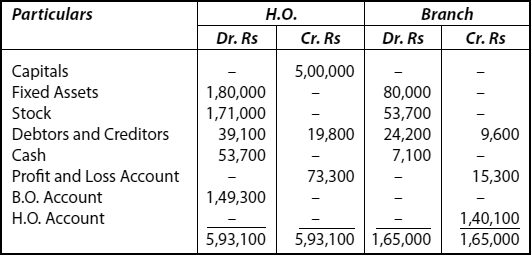
Set out balance sheet of the business as on Dec 31, 2009 and the Journal entries necessary (in both the sets of books) to record the adjustments dealing with the following:
- On Dec 31, 2009, the branch had sent a cheque of Rs 5,000 to the H.O. and not received by H.O. not credited to branch account till Jan 5, 2010.
- Goods valued Rs 4,200 had been forwarded by the H.O. to branch and invoiced on Dec 29, 2009, but were not received by the branch nor dealt with in branch’s books till Jan 9, 2010.
- The profit shown by the branch is to be transferred to the H.O. books.
- Branch assets and liabilities are to be recorded in the books of the H.O.
(B.Com – Modified)
Answer: Balance Sheet Total: Rs 6,18,000
28. The following is the Trial Balance of Goa Branch as on Dec 31, 2009.
| Dr. Rs | Cr. Rs | |
|---|---|---|
Mumbai H.O. |
6,480 |
– |
Stock Jan 1, 2009 |
12,000 |
– |
Purchases |
1,95,600 |
– |
Goods received from H.O. |
38,000 |
– |
Sales |
– |
2,76,000 |
Goods supplied to H.O. |
– |
12,000 |
Salaries |
9,000 |
– |
Debtors |
7,400 |
– |
Creditors |
– |
3,700 |
Rent |
3,920 |
– |
Office Expenses |
2,940 |
– |
Cash at Bank |
3,560 |
– |
Furniture |
12,000 |
– |
Depreciation on Furniture |
800 |
– |
|
|
– |
|
2,91,700 |
2,91,700 |
Stock at Branch on Dec 31, 2009 was valued at Rs 15,400. Account of Goa Branch in the H.O. books stood at Rs 920 (Debit). On Dec 26, 2009, the H.O. forwarded goods to the value of Rs 7,400 to the branch where they were received on Jan 5, 2010.
- Prepare Trading and Profit and Loss Account of Goa Branch for the year ended Dec 31, 2009 and its Balance Sheet on that date.
- Pass journal entries in the books of H.O. to incorporate the above shown trial balance
- Show Goa Branch Account as it would be closed in H.O. Ledger
[B.Com (Hons) Delhi – Modified]
Answer: Gross Profit: Rs 59,600
Net Profit: Rs 41,140
Balance Sheet Totals: Rs 3,08,020]
29. Ashok Ltd. has its H.O. in Chennai and a Branch in Delhi where as separate set of books are used. The following are the trial balances extracted on Mar 31, 20.
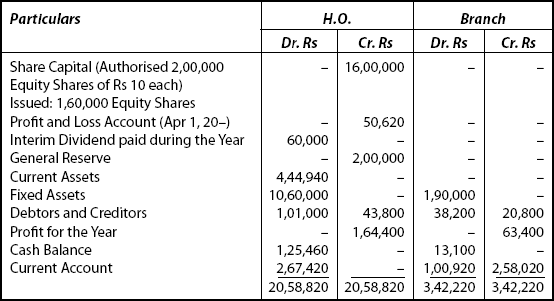
The difference between the balances of the current account in the two sets of books is accounted for as follows:
- Cash remitted by the branch on Mar 31, but received by the H.O. on Apr 2, Rs 6,000.
- Stock stolen in transit from H.O. and charged to the branch by the H.O. but not credited to H.O. in the branch books as the branch manager declined to admit any liability (not covered by insurance) Rs 3,400.
You are required to prepare the Branch Current Account in the H.O. books after incorporating Branch Trial Balance through Journal. Also prepare the company’s Balance Sheet as on Mar 31, 20–.
[C.A. (Inter) – Modified]
Answer: Branch Profit – Rs 63,400
General Profit and Loss Account – Rs 2,15,020 (cr.)
Balance Sheet Totals – Rs 20,79,620
30. The following are the Trial Balances of VRS Ltd Chennai, and its Delhi Branch as on Dec 2009:

Closing Stock at H.O. was Rs 77,400; and at Delhi Rs 57,400. Depreciation is to be provided @ 10% p.a. on machinery and @ 15% p.a. on furniture. Rent still payable in respect of Dec 2009 for the branch godown is Rs 600.
You are required to prepare the Trading and Profit and Loss Account in Columnar form and the Consolidated Balance Sheet. Also show the Branch Account.
[C.A. (Inter) – Modified]
Answer: Gross Profit: H.O. Rs 2,29,200; Branch – Rs 45,800
Net Profit: H.O. Rs 97,900
Net Loss: Branch Rs 1,600
Consolidated Balance Sheet Totals: Rs 5,58,380]
